The co-production designers on the series explore mysterious At Attin, gorgeous Lanupa, the bustling pirate port of Borgo, the Onyx Cinder, and more!
The very idea of Star Wars: Skeleton Crew — an adventure told from the perspective of four young travelers seeing the wider world for the first time — invites the design of new worlds in rich color palettes, transfixing the characters and fans at home with all the splendor and danger the galaxy far, far away has to offer. From the beautiful spas of Lanupa to war-torn At Achrann, the production design had to reflect the vast array of cultures and denizens the Onyx Cinder’s explorers encounter as they try to find their way back home to At Attin.
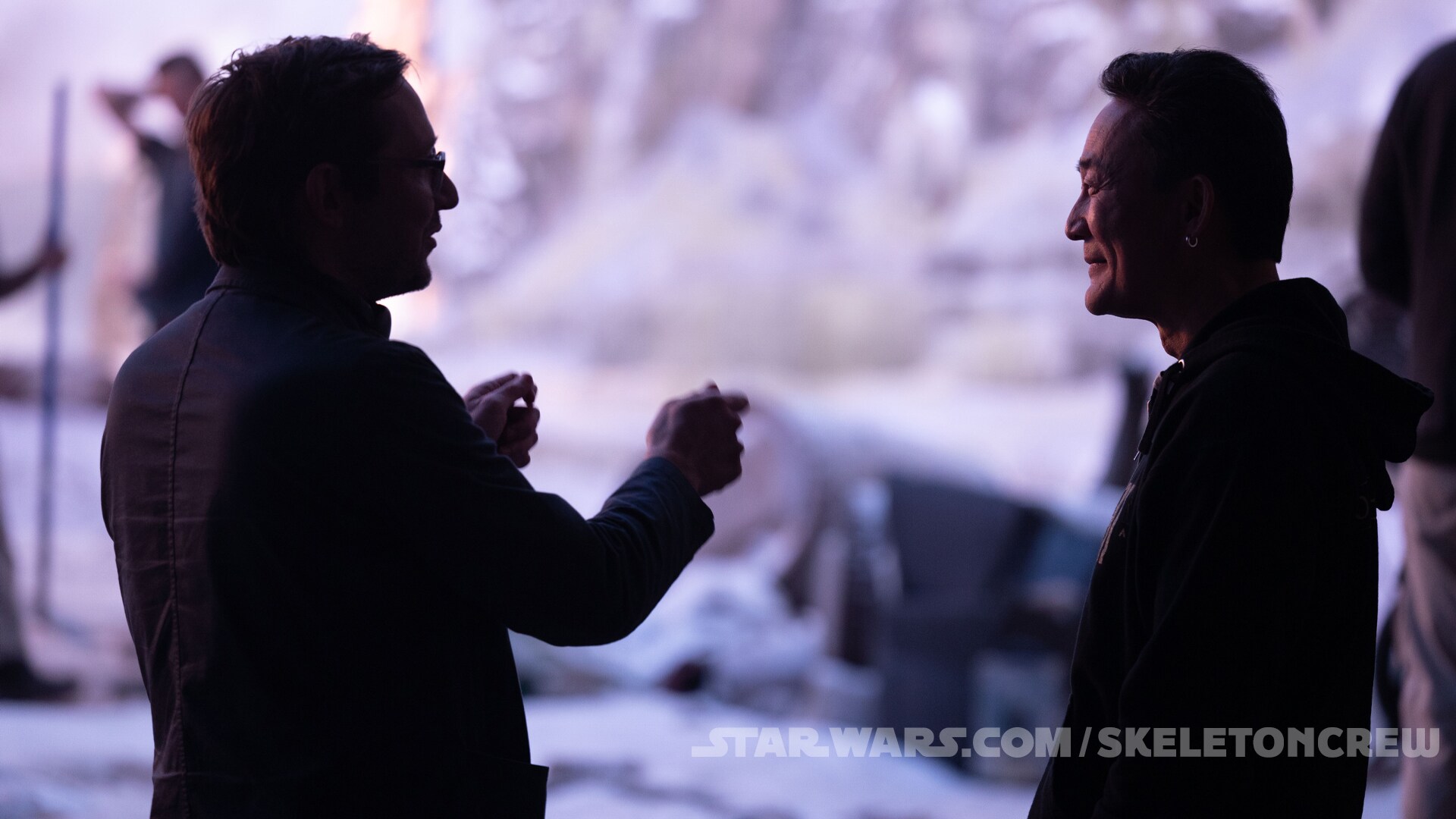
Behind the scenes, co-production designers Doug Chiang and Oliver Scholl tackled the job with more than half a century of filmmaking experience between them. “One of the joys of working with Oli is that it's a terrific collaboration, because he brings a very distinct perspective to it,” says Chiang, Lucasfilm's Senior Vice President and Executive Design Director. “I love those kinds of collaborations because we get fresh ideas. He may suggest something that I hadn't thought of before, and it's a terrific way of world building. It feels more authentic, and I think that's one of the things that's so important for Star Wars, is that we want this to feel authentic.”
Having worked as a concept artist on films like Back to the Future Part II, Chiang served as design director on Star Wars: The Phantom Menace before working as production designer on Rogue One: A Star Wars Story, The Mandalorian, and Ahsoka. Scholl’s first Hollywood production design job was on Independence Day, followed by projects like Edge of Tomorrow and Spider-Man: Homecoming, where he first worked with Skeleton Crew creators Jon Watts and Chris Ford.
Spoiler warning: This article discusses story details and plot points from all eight episodes of Skeleton Crew.
Nevertheless, creating the worlds of At Attin, Starport Borgo, Lanupa, and beyond presented unique challenges, not to mention the Onyx Cinder, a brand-new type of starship with set components that had to rotate 180-degree. With a bold new aesthetic defining each new locale coupled with nostalgic homages to Steven Spielberg films of the 1980s, the worlds of Skeleton Crew are here to welcome you with eight episodes now streaming on Disney+. “We wanted to pay respect to Spielberg’s films, but at the same time world-build at a level that we've always wanted to do for Star Wars,” says Chiang. “We wanted to fill every frame with a visual spectacle while supporting the story. I think it’s one of the most beautiful series that we've done and it has a touch of nostalgia.” Recently, we sat down with Chiang and Scholl to pull back the curtain on the series’ many locations.
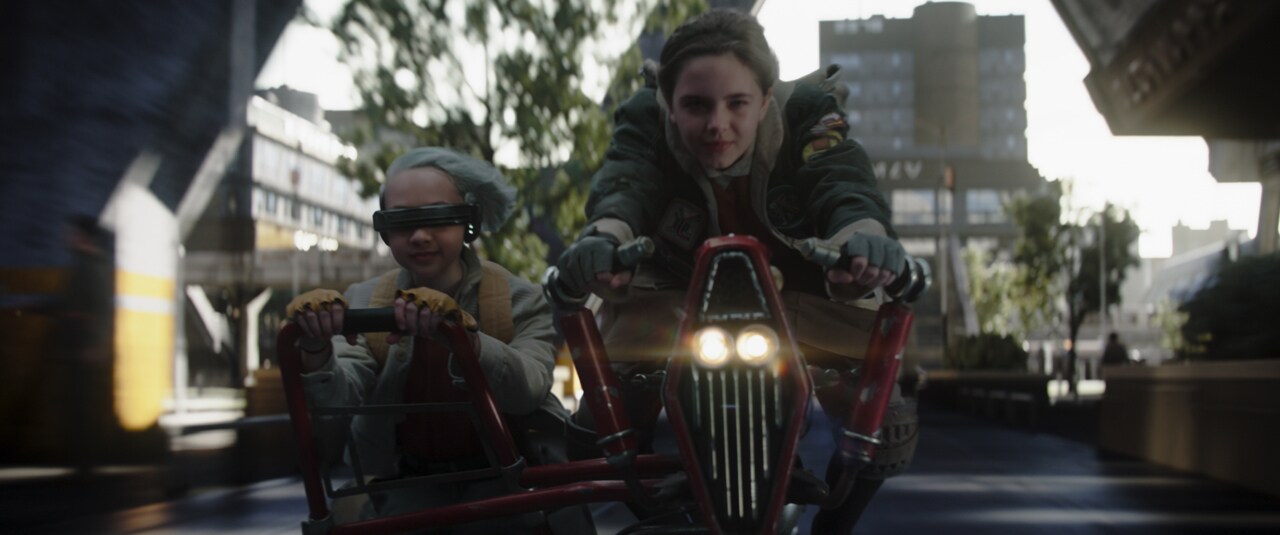
Exploring At Attin
Scholl took the lead on designing At Attin, the serene homeworld of the four young protagonists — Wim (Ravi Cabot-Conyers), Fern (Ryan Kiera Armstrong), Neel (Robert Timothy Smith), and KB (Kyriana Kratter). The planet had to be at once painfully dull and blissfully safe, reflecting the emotions of the kids and their parents through the look and feel of identical homes dotting the quiet cul de sac, the school tram, and the downtown. “There’s a sense of dread,” Scholl says. “The kids want to have an adventure and they're stuck there.”
“Clarity is really important to show the progression of the journey,” adds Chiang. “We were very conscious of using the color palette to distinguish the environments. And it's one of those things where George [Lucas] had established that idea way back. He was very clear in terms of lighting and color and texture and form so that the viewer knows where they are. The color palette, for instance, on At Attin is your Spielberg suburban neighborhood with beautiful lighting. There are some sunset shots that are very Spielberg."
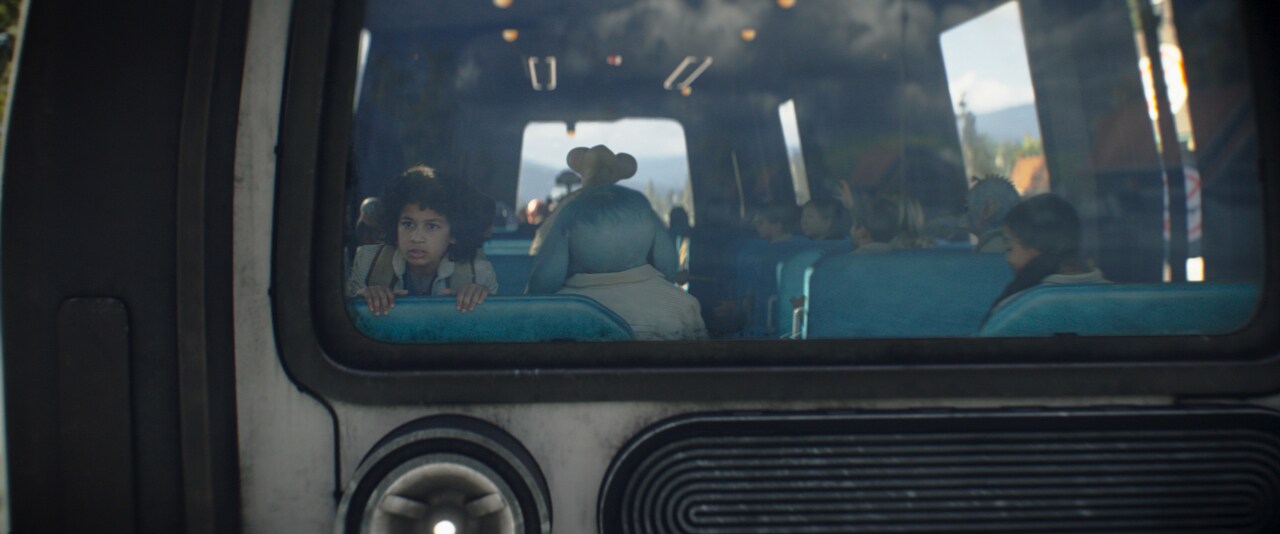
The school tram evokes the yellow buses of American public schools with a blocky, rectangular shape and rows of bench seating. “We didn't want to go so obvious as to turn it yellow,” Chiang says. “But there are very similar form languages in there and that was very specific because we didn't want to turn it into a subway car. It's a school bus, but our Star Wars version.”
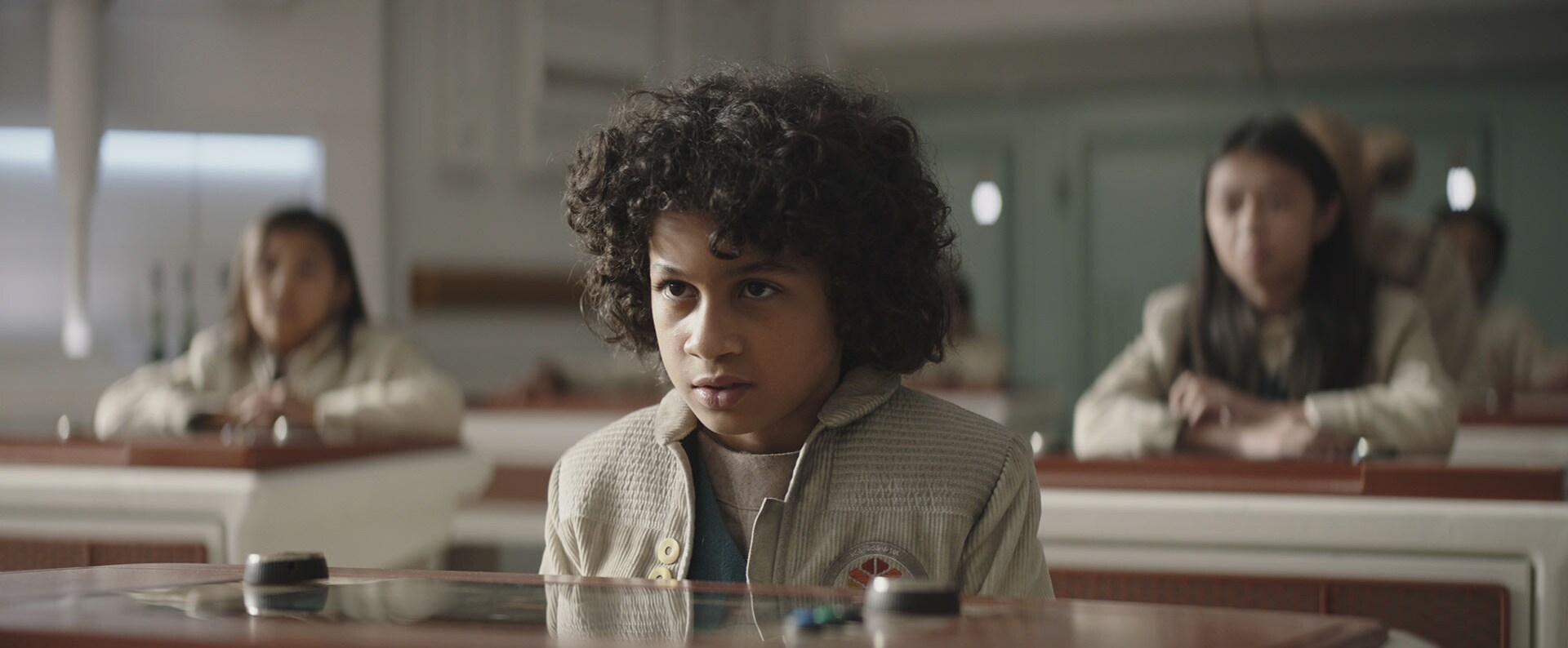
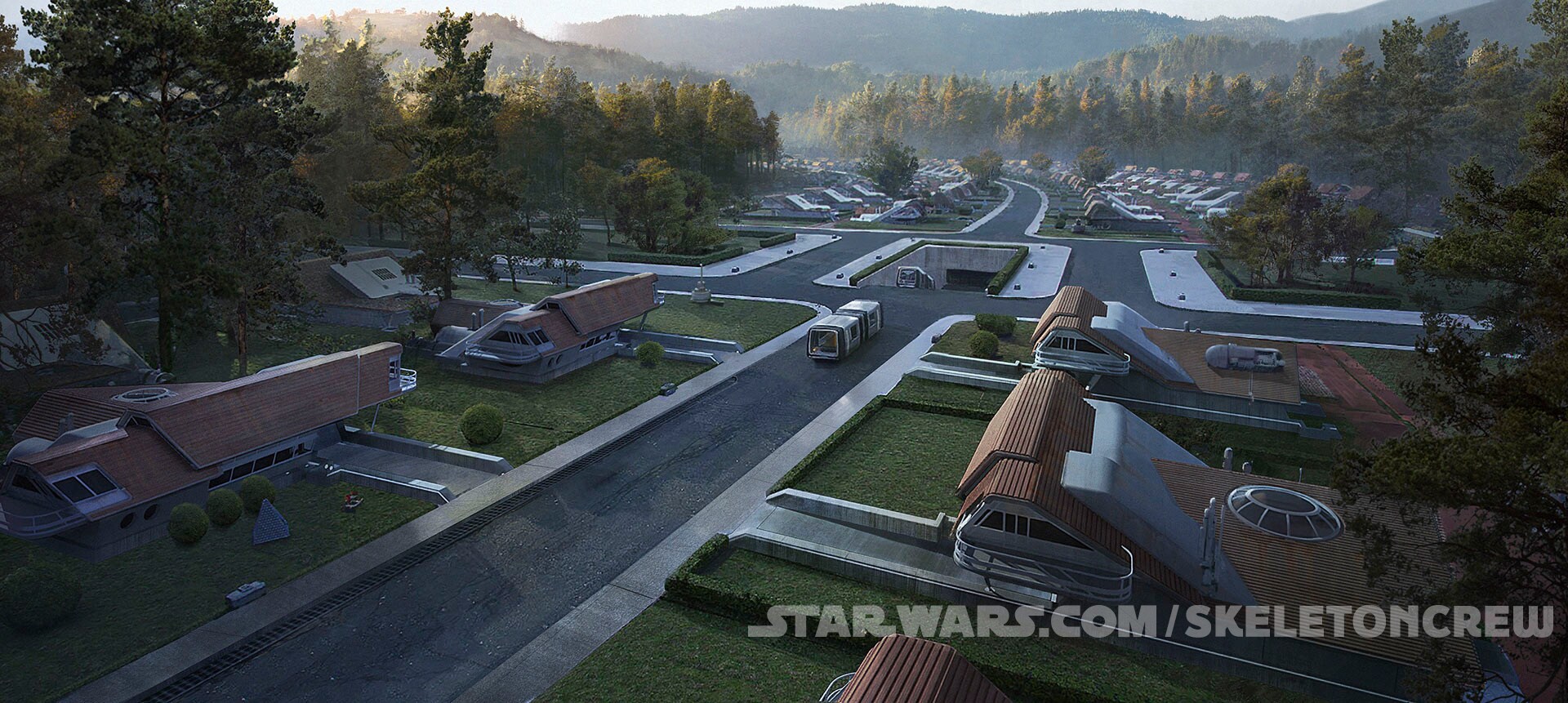
Even the layout of desks in the classroom, lockers, and a large screen behind the droid teacher feels distinctly familiar. “The hallways are something that you could find on Earth in terms of the layout of the structures,” Chiang says. There’s even a callback to Scholl’s earlier collaboration with Watts and Ford, courtesy of set decorator Gene Serdena who also worked on both productions. “In Homecoming, we had the science experiments on the walls and along the sides,” Scholl says, “and we did the same thing here.”
Scholl pulled from earthbound architecture to solidify his concrete jungle of grid-like cityscapes surrounded by more swirling suburban abodes. “Star Wars has shown us many different cities, from glamorous to rundown and falling apart,” says Scholl. “In our case, we went with a brutalist architecture style. It has ornamental elements like in Soviet architecture and there are some Le Corbusier [the Swiss-French architect Charles-Édouard Jeanneret] elements in the city development.” Urban development studies in the style of Kenzo Tange helped inform some details as well as an old photo Scholl found of a now defunct Armenian airport in the brutalist style. “I think it doesn't exist anymore, but that led to some inspiration for building shapes around the central plaza. It's basically a ton of concrete with structure and texture on it.”
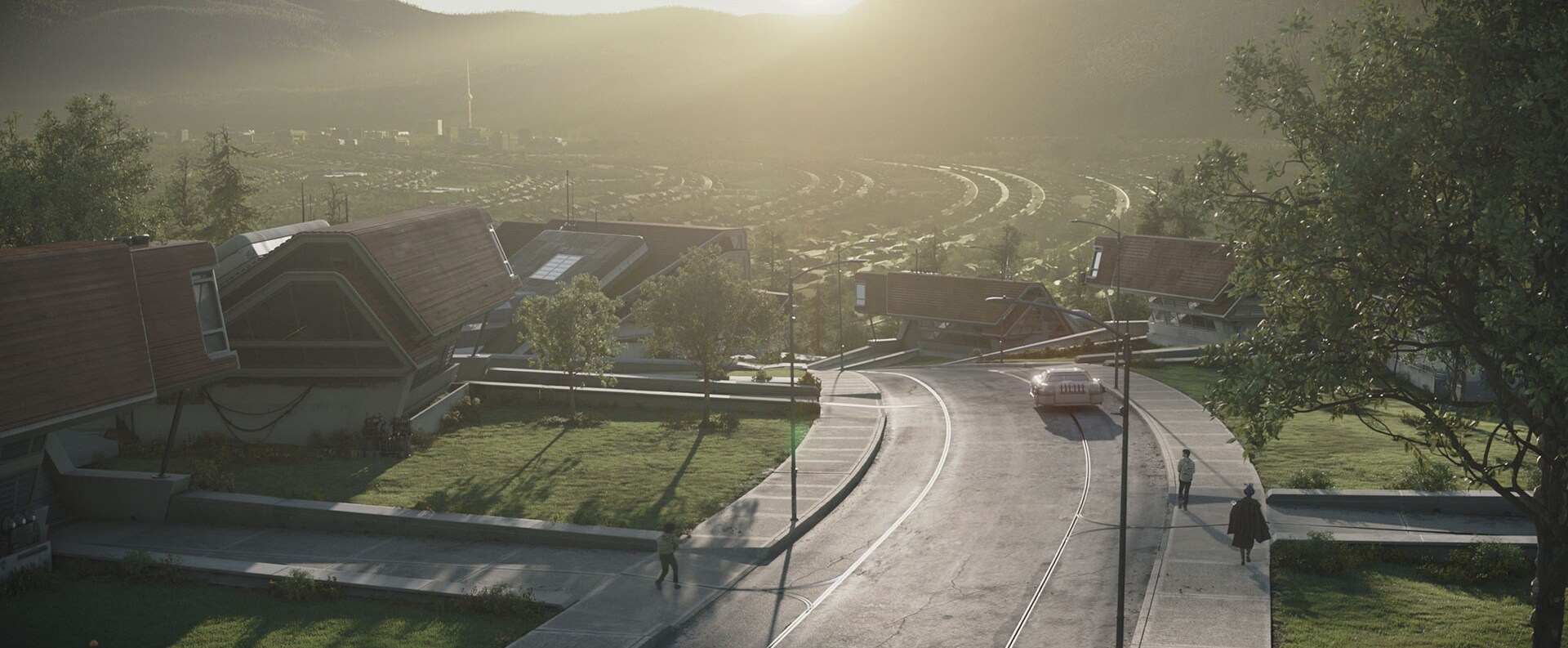
Outside the city center, structures are more spread out and painted in earthy tones, with prominent and identical sloping roofs that could be seen from afar and mid-century modern interiors with a sci-fi twist. “When I rewatched E.T., the strongest element I saw was the rooftop shapes,” Scholl says, just a hoverbike ride away from the forest and adventure.
In pre-production, the sprawling landscape was laid out in the Unreal Engine with help from Industrial Light & Magic, so directors could scout their locations in virtual reality. “We wanted to have the classic Star Wars forest and not emphasize that we're on an alien planet,” Scholl says. “This is their home. They're used to it. It is more about the sense of wonder that there's something out there.”

By the finale, the audience and the young residents have discovered that there’s much more to their home that at first meets the eye. Hidden behind the Barrier is one of the last known Old Republic mints, the true meaning of the fabled eternal treasure. After finally finding their way back, Jod, Wim, Fern, KB, and Neel land the Onyx Cinder and descend into the previously unseen vaults. “It's a very peaceful sort of mundane world on top, but then when you go down deep underneath, there's the machinery of all that,” Chiang says, as our heroes head toward the planet’s core. “We really wanted to play into the drama…to create this idea that deep in the planet was this hidden vault, almost like Fort Knox. We really played up the actual motif of giant vault doors. We took a bank vault and just scaled it up by a thousand so that it looks like this immense structure in there filled with gold. And the lighting quality really played into that as well.”
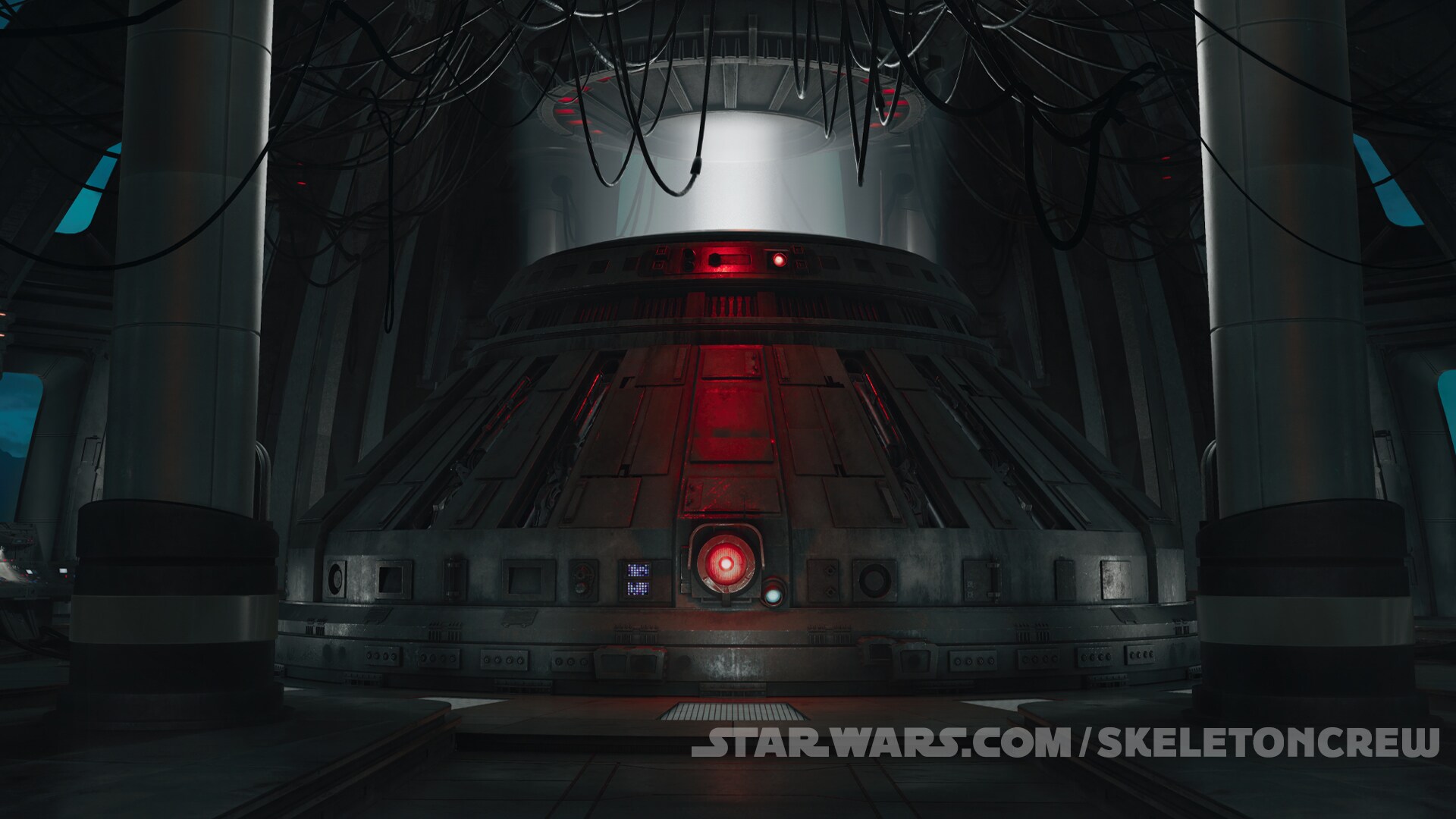
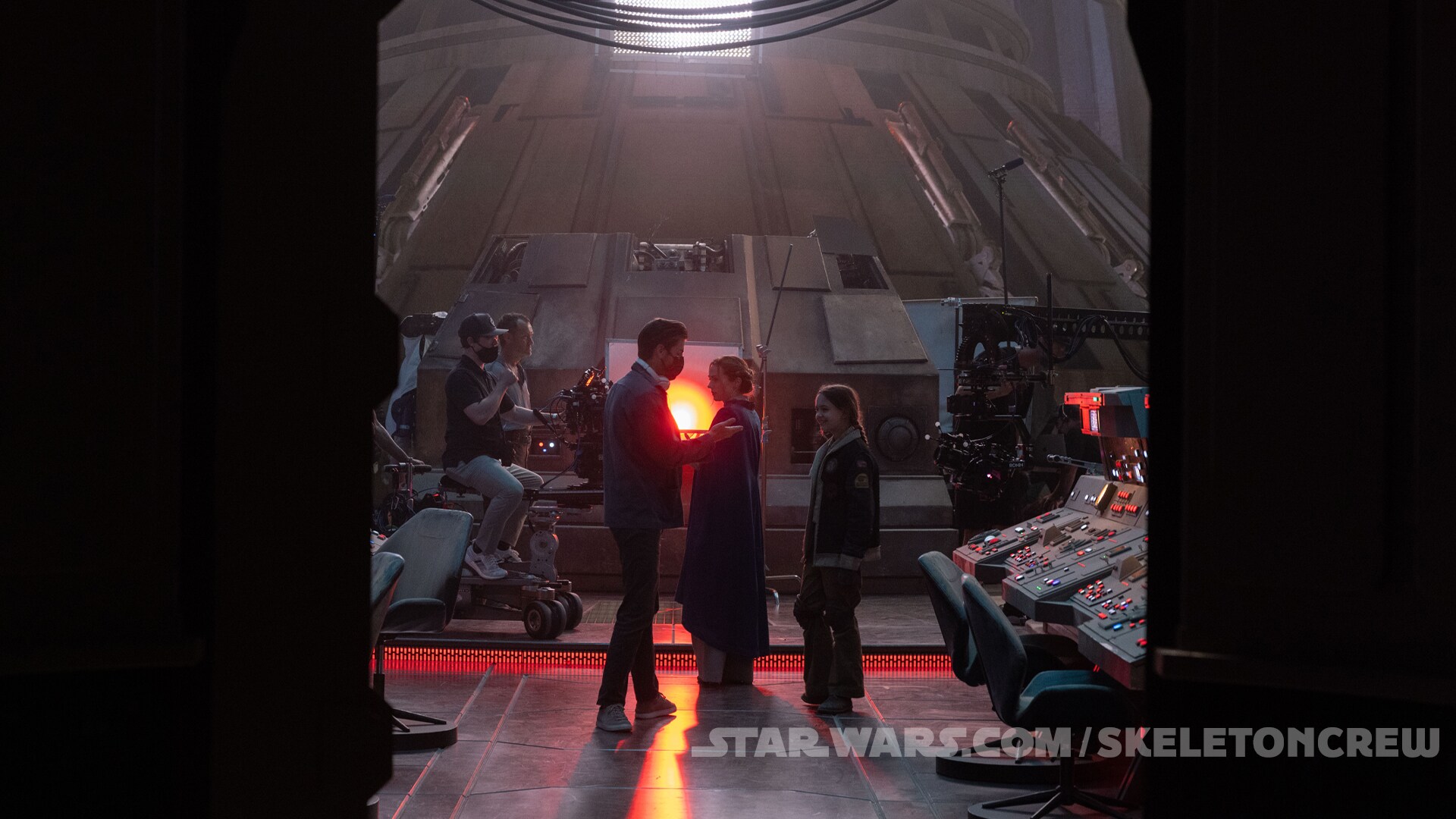
The journey into the Supervisor’s Tower also provided an opportunity to use Industrial Light & Magic’s StageCraft technology to create the illusion of a massive domed droid head in the center of a room that would have been impossible to create using practical effects alone. “It worked really well because you have this very simple shape with a single eye,” Chiang says. “Obviously, that head was gigantic. I mean, there's no way we could have built anything like that [with the] moving mechanisms on there and have it rotate at the same time. The Volume can actually give us the dynamic animation quality of a giant set that we couldn't do physically….It speaks to droids, but also the scale of it makes you wonder, ‘Wow, what is this creature or character? What is this supervisor being?’”
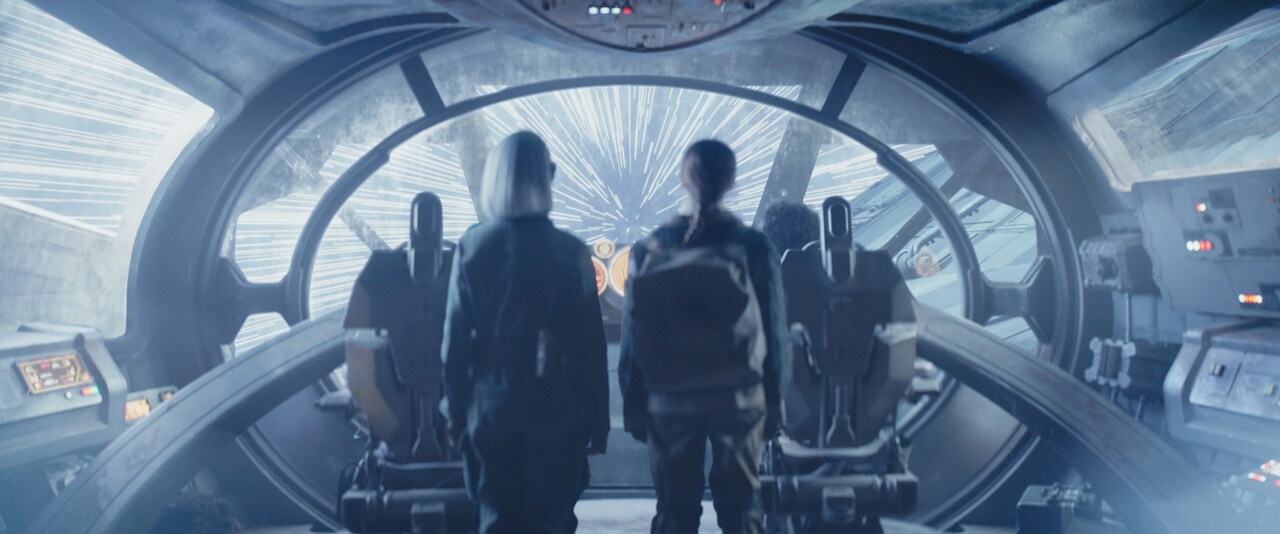
Aboard the Onyx Cinder
Once our heroes discover that what Wim thought was a Jedi temple is actually a ship, the Onyx Cinder quickly becomes something of a home away from home. The designers knew they had to create a unique silhouette that also paid homage to other Star Wars ships, taking great care to incorporate decorative elements from previously established pirate ships in The Mandalorian season three. “Space ships are really hard because we treat them like characters. They need personality,” Chiang says. “And the Onyx Cinder had to be our version of something that was very magical in terms of both design and form for the story. And we wanted to go for a unique silhouette.”
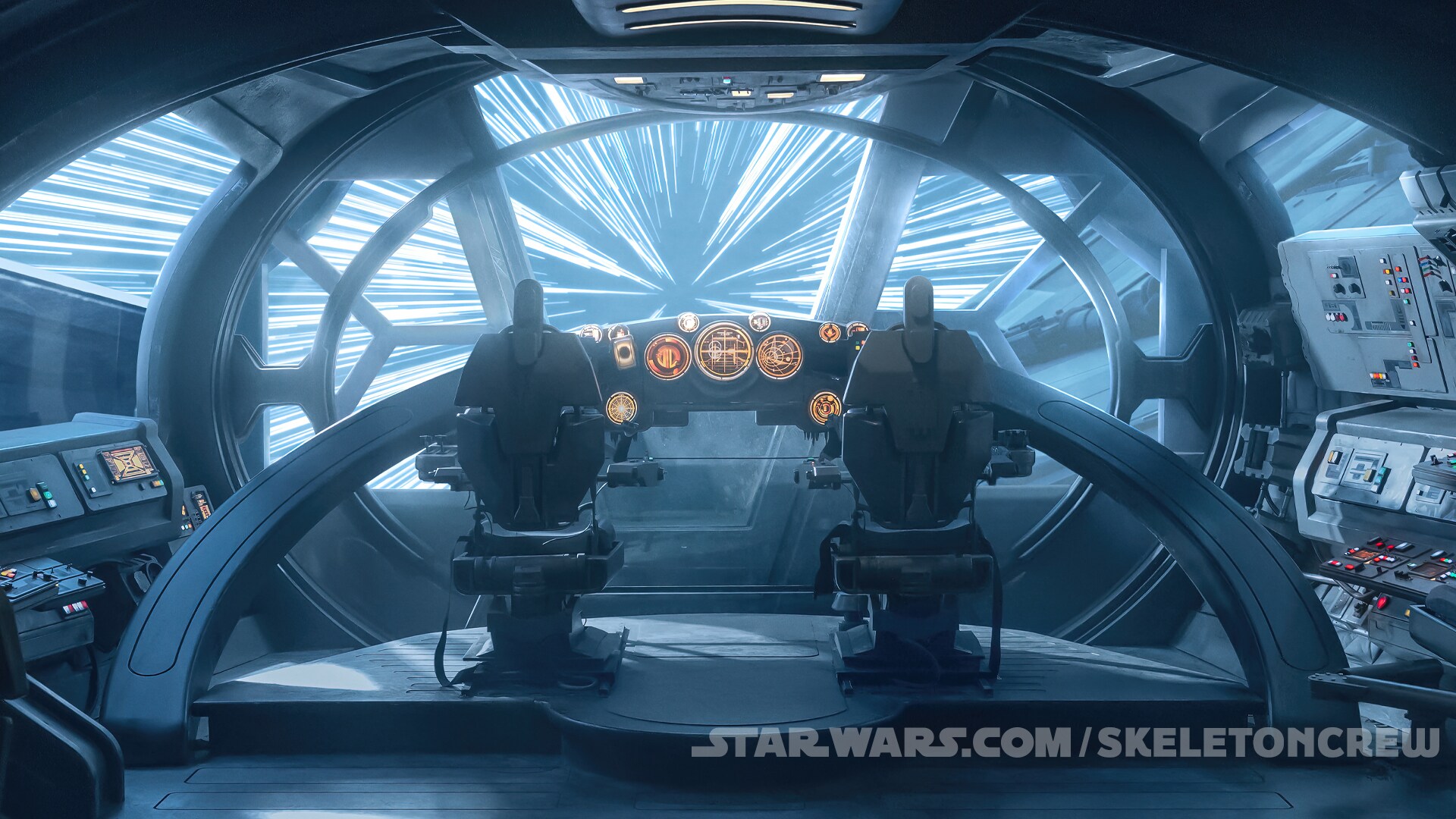
Like the Millennium Falcon, the cockpit sits off to one side of the ship, although this version is wider to allow for the full crew — including Jod (Jude Law) and SM-33 (Nick Frost) — to fit inside all at once. “It's rugged. I mean, it looks like a junker. And that was on purpose,” says Chiang. “We wanted personality. We wanted this ship to be really interesting and really powerful because when the kids discover it, it’s upside down and the big reveal is the surprise as it turns over. That's the beauty of working with Watts and Ford; they love these visual tricks to keep the audience off balance, but then when you discover what it is, you get the joy of, ‘Oh wow, this is a really cool spaceship!’”
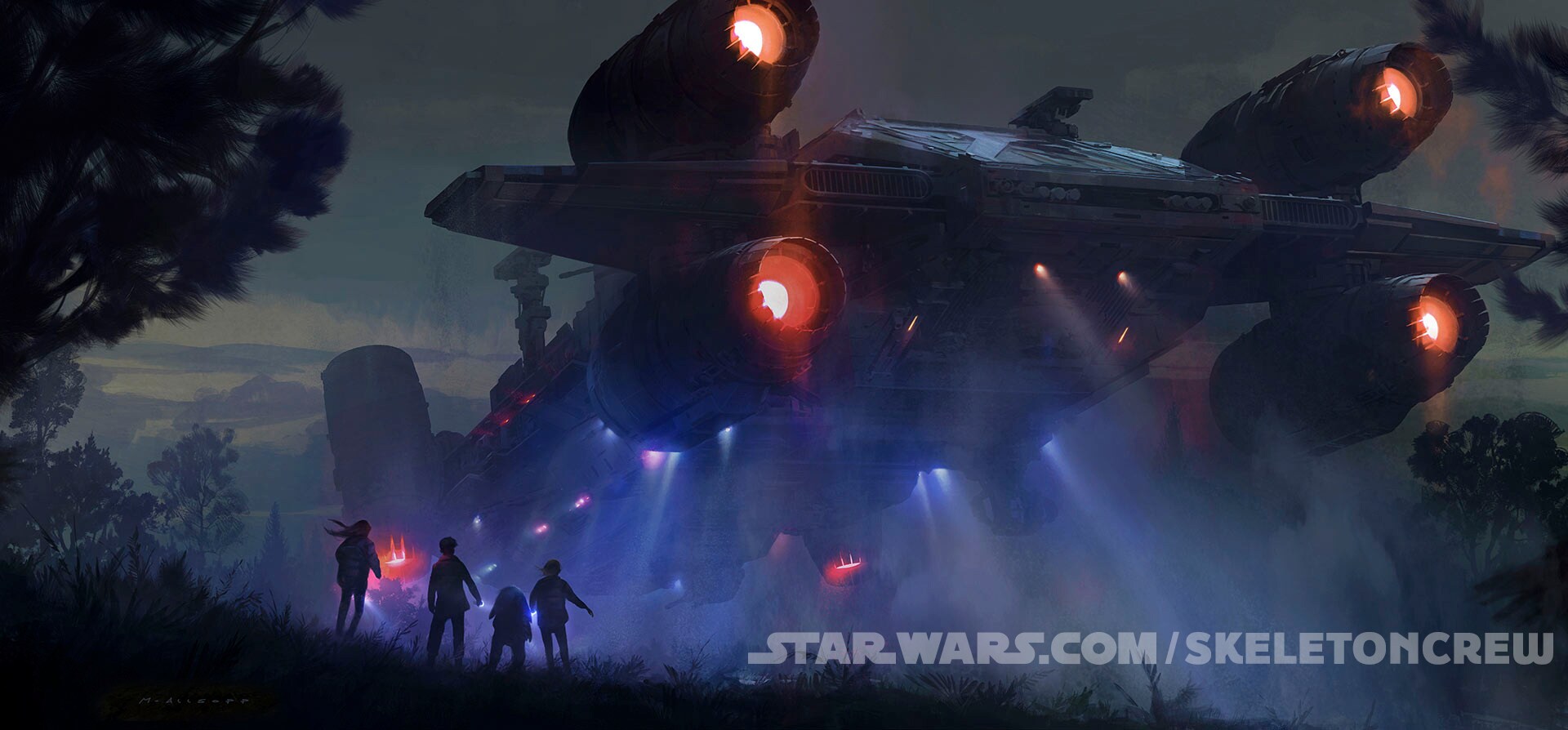
The six engines on the outside of the ship accommodate that rotation, while the black and white stripes on the hull lean into its pirate past, helping to visually tie the ship to the rest of the fleet from The Mandalorian. “In season three we had this cruiser with these very distinct zebra stripes, and it created a foundation for our pirates in our series,” Chiang says. “The starting point was ironclad armored warships of the Civil War from 1860,” adds Scholl. “We came across this black and white image that shows these steam-powered ships. They look like stealth ships because they're just these blocks with these beveled handles of thick armored steel.” The shape became the inspiration for the nose of the Onyx Cinder. “The other elements that are classic Star Wars when you look at this is kit bashing,” Scholl adds. “The way the surface has a lot of detail, things that give it scale. We have two classic circle gunports there. We've got the big loading ramp and the engines that are mounted on the top and bottom of the wings.”
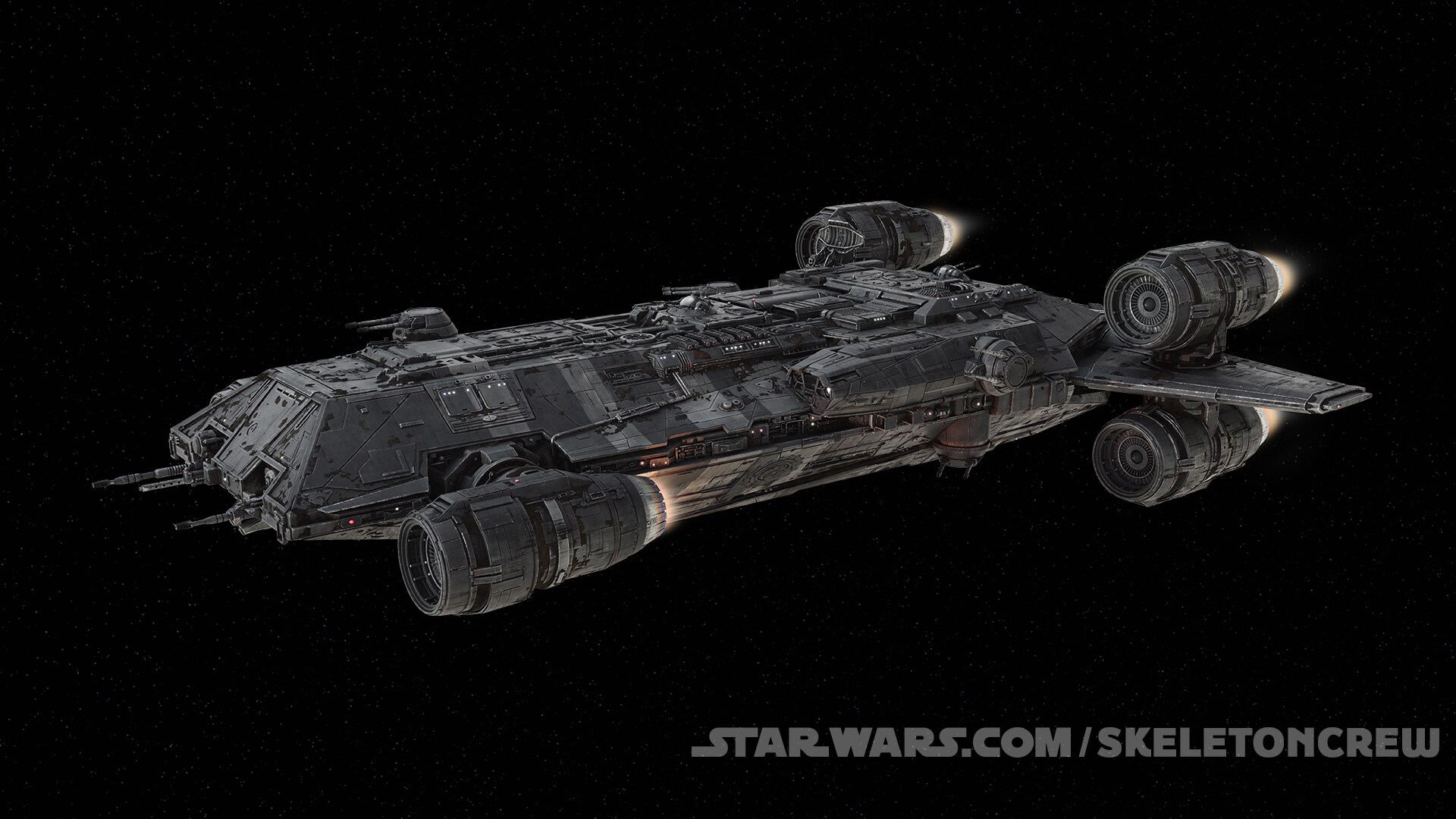
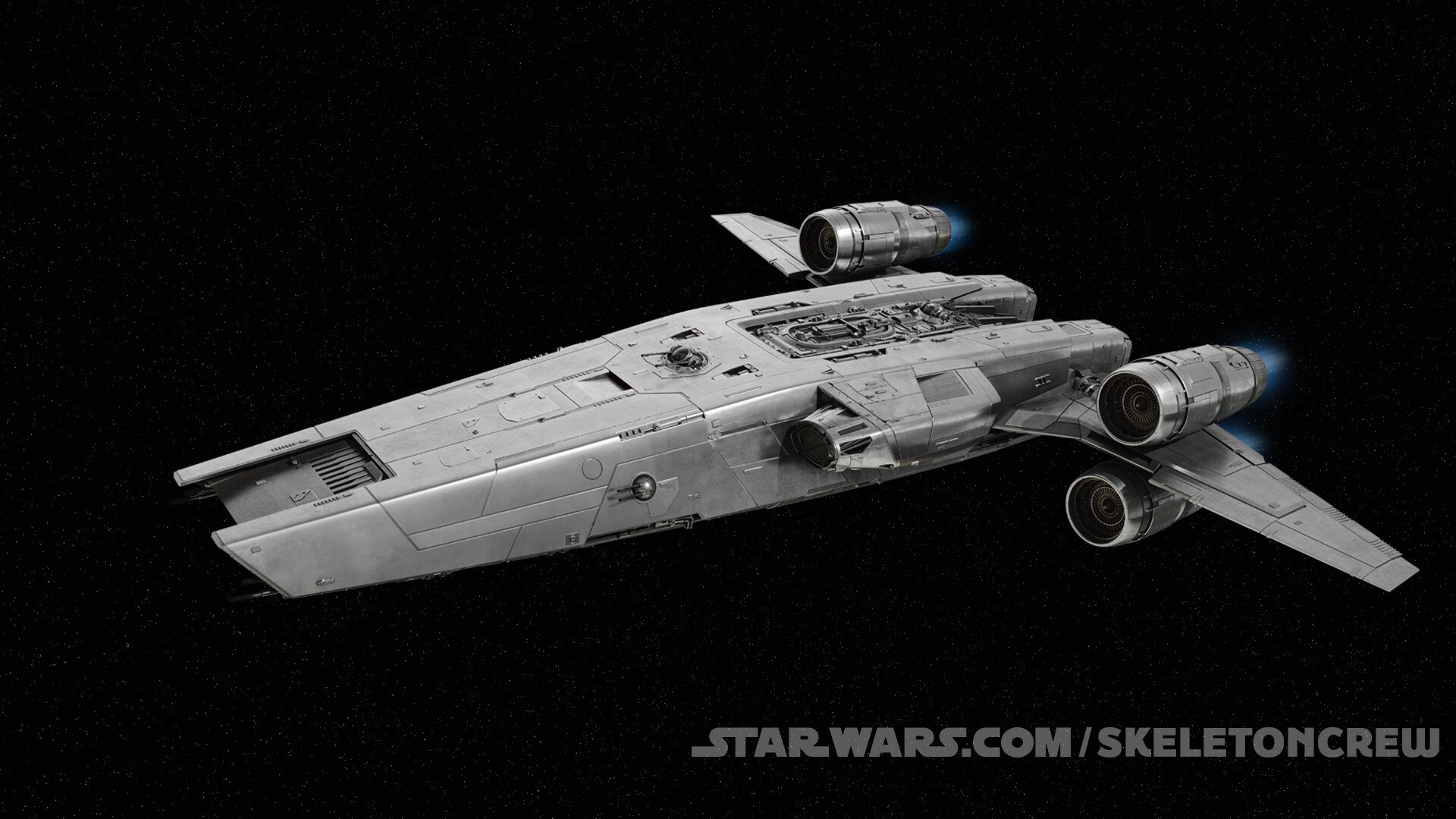
And the design team had to take into account that in episode 6, the emergency hull demolition sequencer would reveal a sleeker, cleaner ship beneath the armored exterior. In pre-production, the final form of the vessel was designed first, then reverse-engineered with the armored plating and black and white pirate stripes. “The challenge there was that it had to work on so many different levels,” Chiang recalls. “The sleek version we made silver because we wanted that contrast. It very much calls back to the Naboo aesthetic in terms of the elegant chrome ship. We thought early [on] that it might be an early Jedi ship and could it be something that was a hundred years old that was very sleek, and that it leaned toward the Queen's aesthetic in terms of form language.”
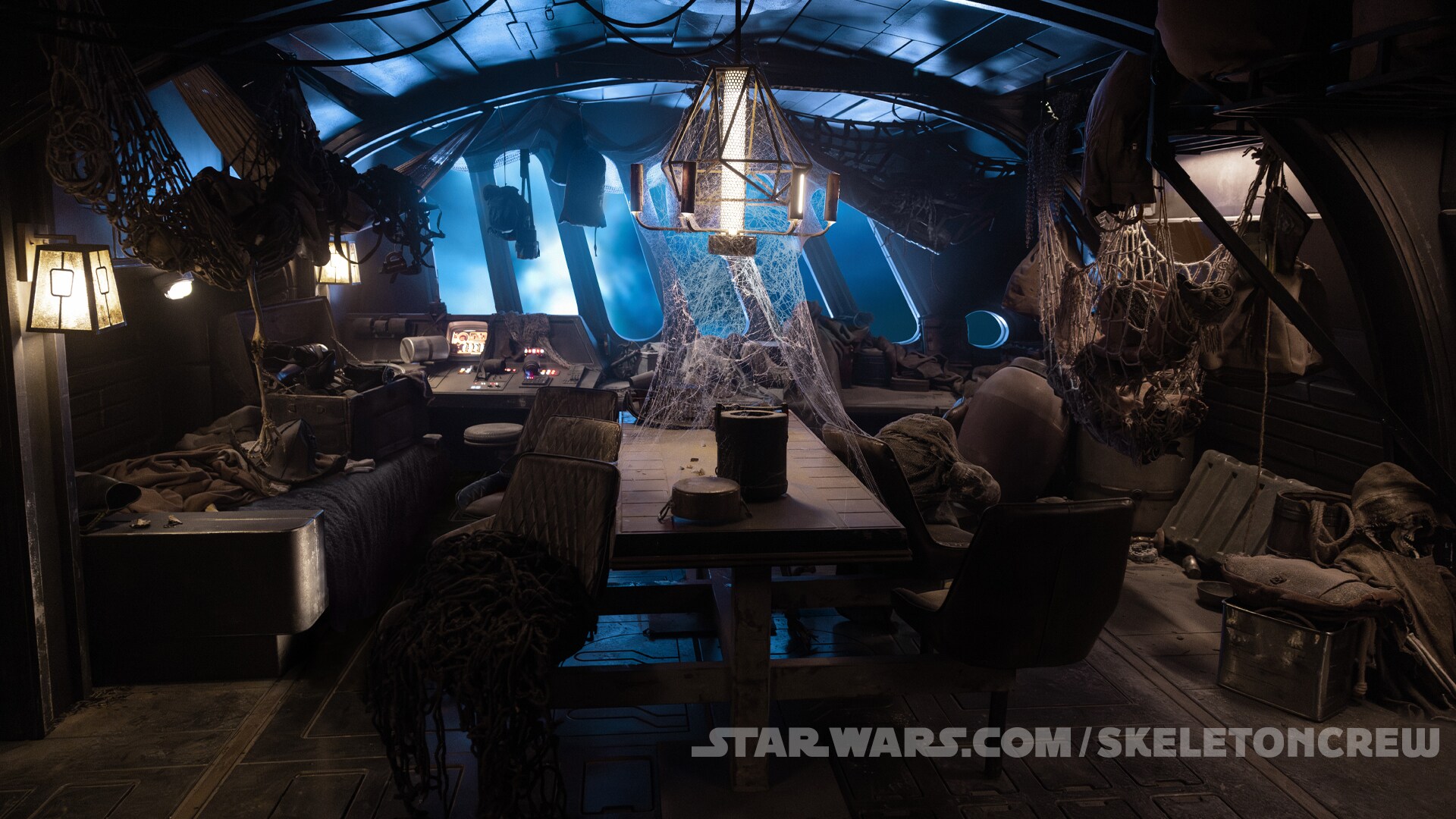
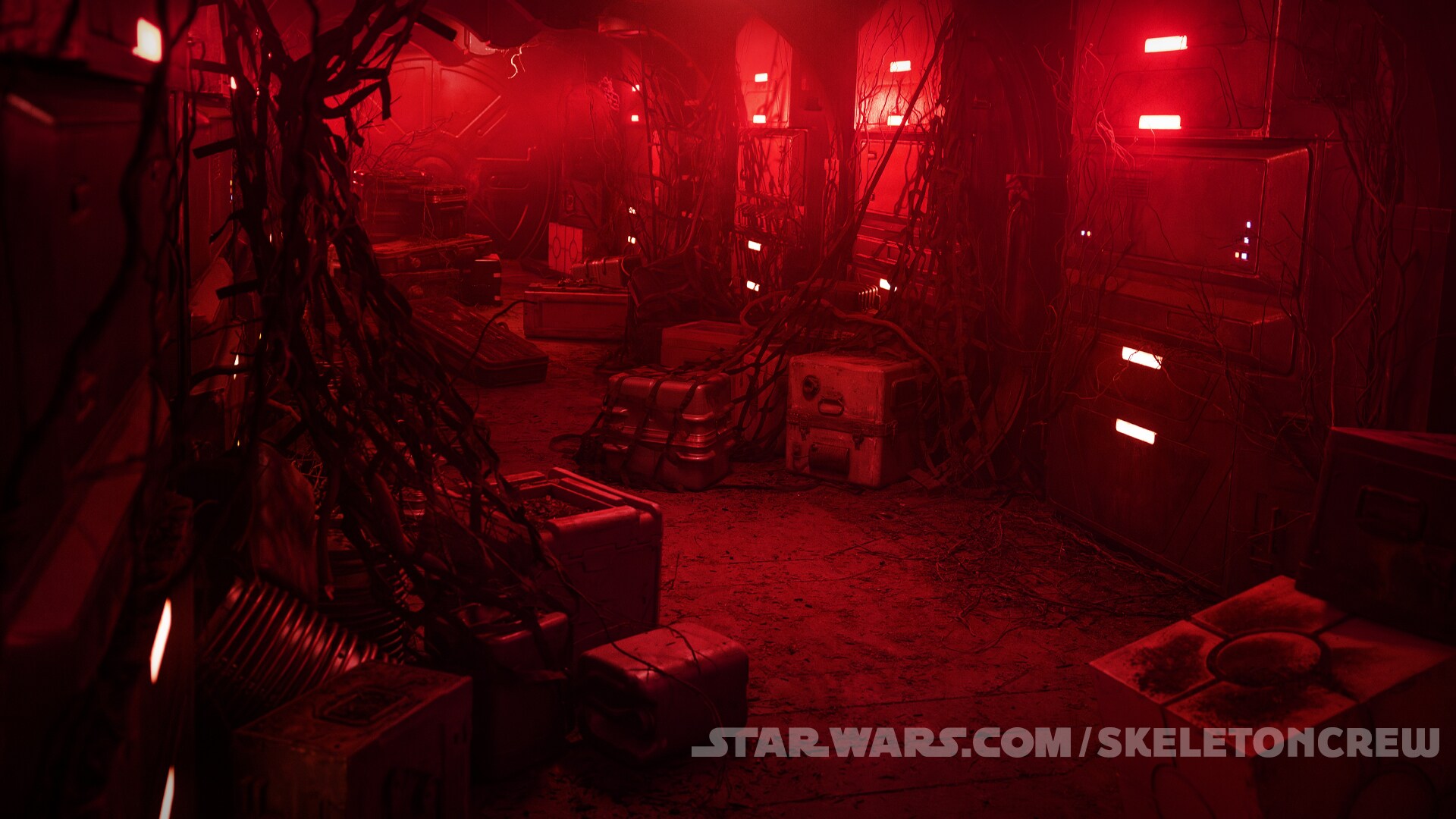
Inside, designers and set decorators added crates, barrels, netting, and ropes to dress the 1:1 soundstage set that could also be flipped upside down, complete with long hallways of up to 150 feet each giving the characters plenty of room to run around. “You can't build two sets, one right side up and one upside down,” Scholl says. “We had to come up with a smart way of being able to have some key elements in the set that we could rig to be on the ceiling or on the floor, and the rest was symmetrical.”
“It was really important to Jon Watts that there was this magical moment when they go in the cockpit and they almost see the front windshield as a mirror,” Chiang adds. “Wim sees his reflection, and he doesn't know that he's in a spaceship yet. When the ship actually starts to flip over, that becomes the front windshield, which had to be flat so we could get that effect.” To further camouflage the true nature of Wim’s discovery, the seats were crafted to fold down, obscuring their shape. “That created a lot of challenges,” Chiang says. “Oli and I had to be very clever in terms of the design so that when it's right side up, it's still the same footprint.” A retractable control panel completed the effect for the cockpit, while elsewhere on the ship the team defined the hallways with distinct buttresses that could be shifted from the floor to the ceiling to complete the flipped-over effect.
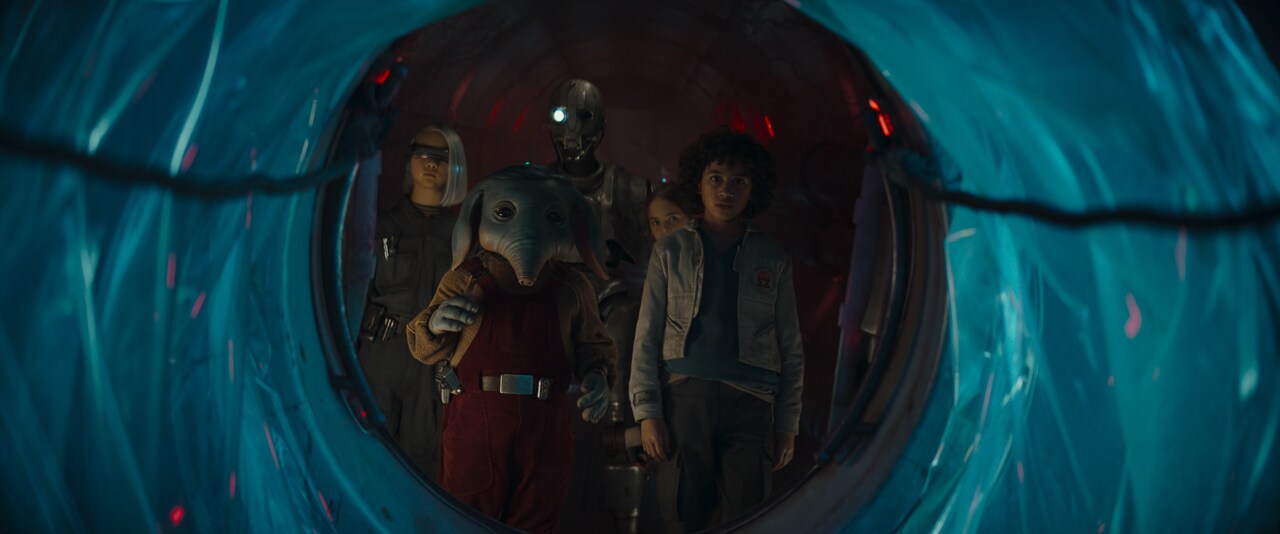
The wretched hive of Starport Borgo
The first stop on this new adventure: the pirate haven of Starport Borgo! Carved out of an asteroid and overlooking a shimmering blue nebula, the design evokes nautical elements and a seaside dock. “There's literally a boardwalk on the front edge,” Scholl notes, alongside floating piers that tether massive visiting ships. “We laid out the ships as if they're floating on water,” adds Chiang.
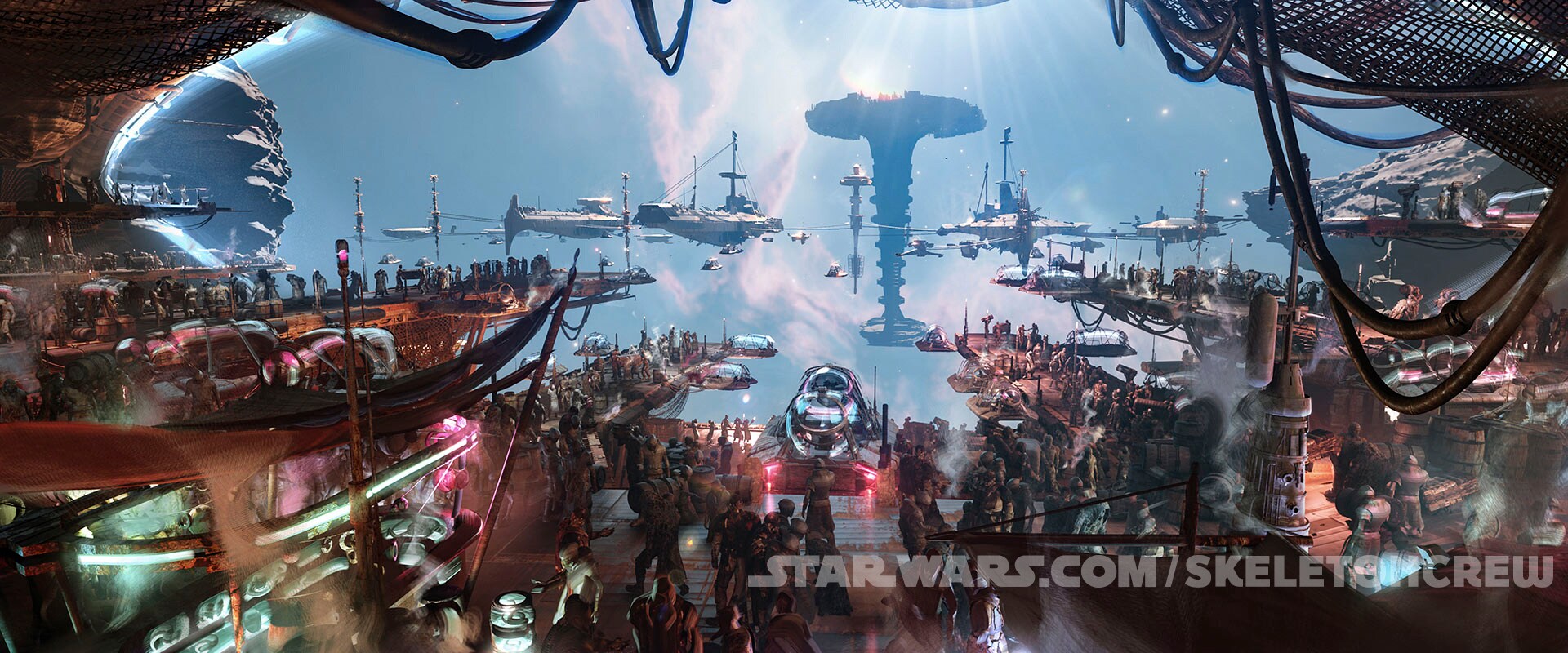
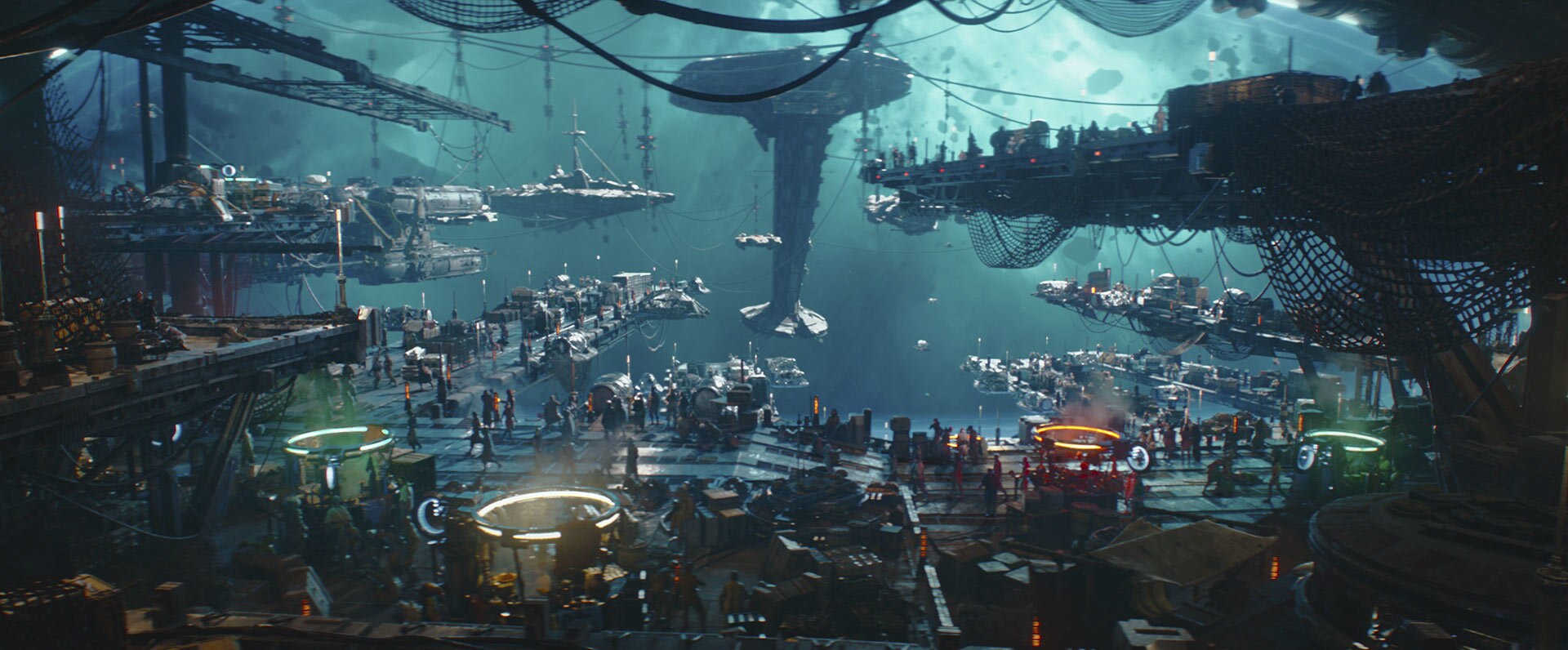
Like a medieval city fortress, different levels are carved into the rock, narrowing as the design ends in the lower-level caves where the brig keeps scoundrels and rogues under lock and key. Set decorators added barrels and other fine details to give the port its bustling feel. “You see crates with exotic creatures instead of chickens,” says Chiang. “All those things help build this world out. Port Borgo was a really fun and challenging environment. It took a lot of development to get here, but I think it hits all the right notes.
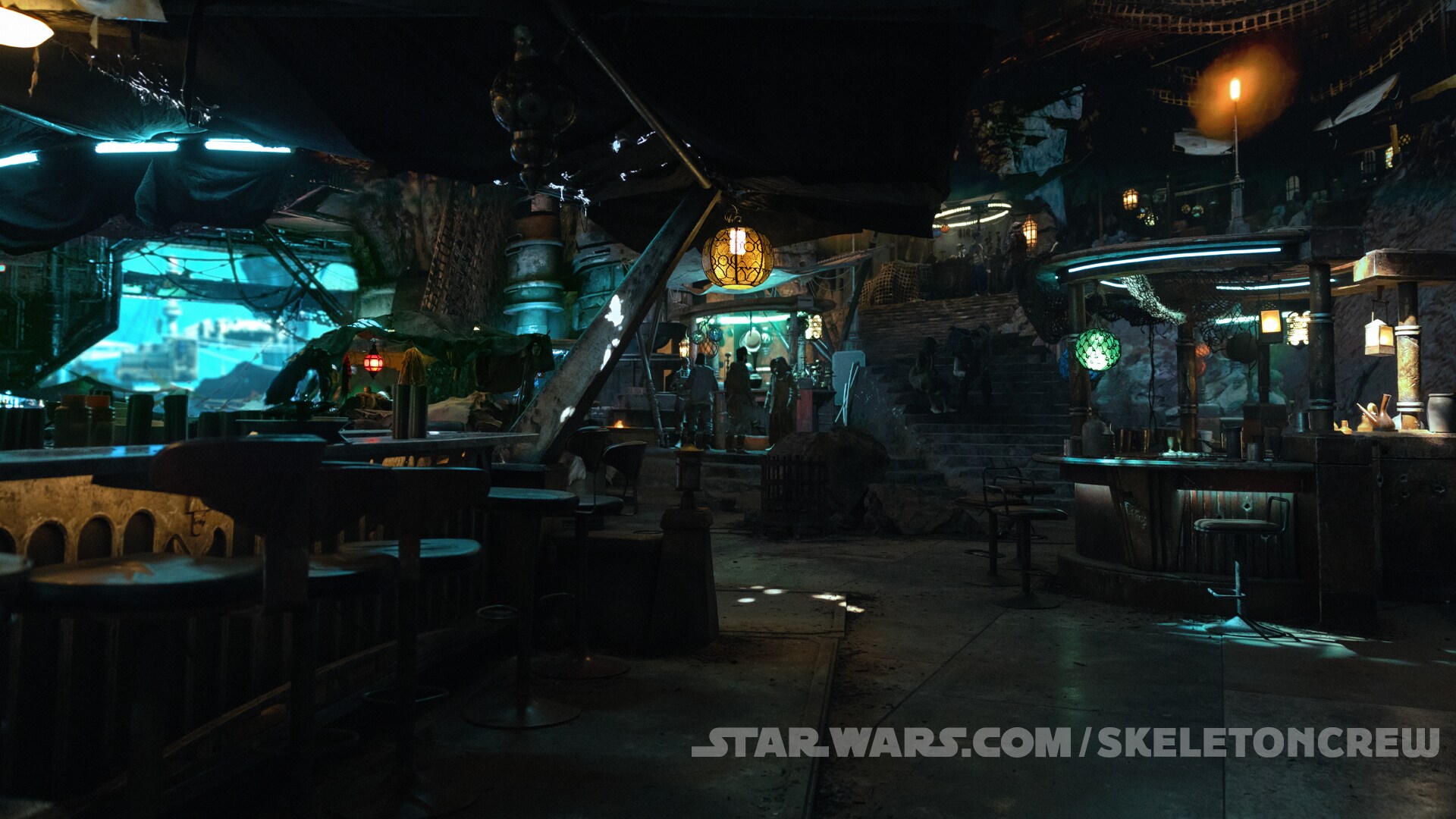
“One of the challenges for us is we've seen so many starports and smugglers’ towns, and we wanted ours to be distinct,” Chiang adds. “Instead of putting it out in space, we put it into a nebula so you have this beautiful blue light that simulates and invokes water. And that was really important because if you look at the design of it, it's carved out like a bay. And it's very specific because we're trying to hint at things that we may instinctually know, but may not quite identify at first viewing. And if you look at films like Pirates of the Caribbean, the island hideouts are very specific. It's configured the same way. And the lighting was really critical because that blue gave you that feeling of water without being water. It's supposed to be hidden. It's supposed to be protected.”
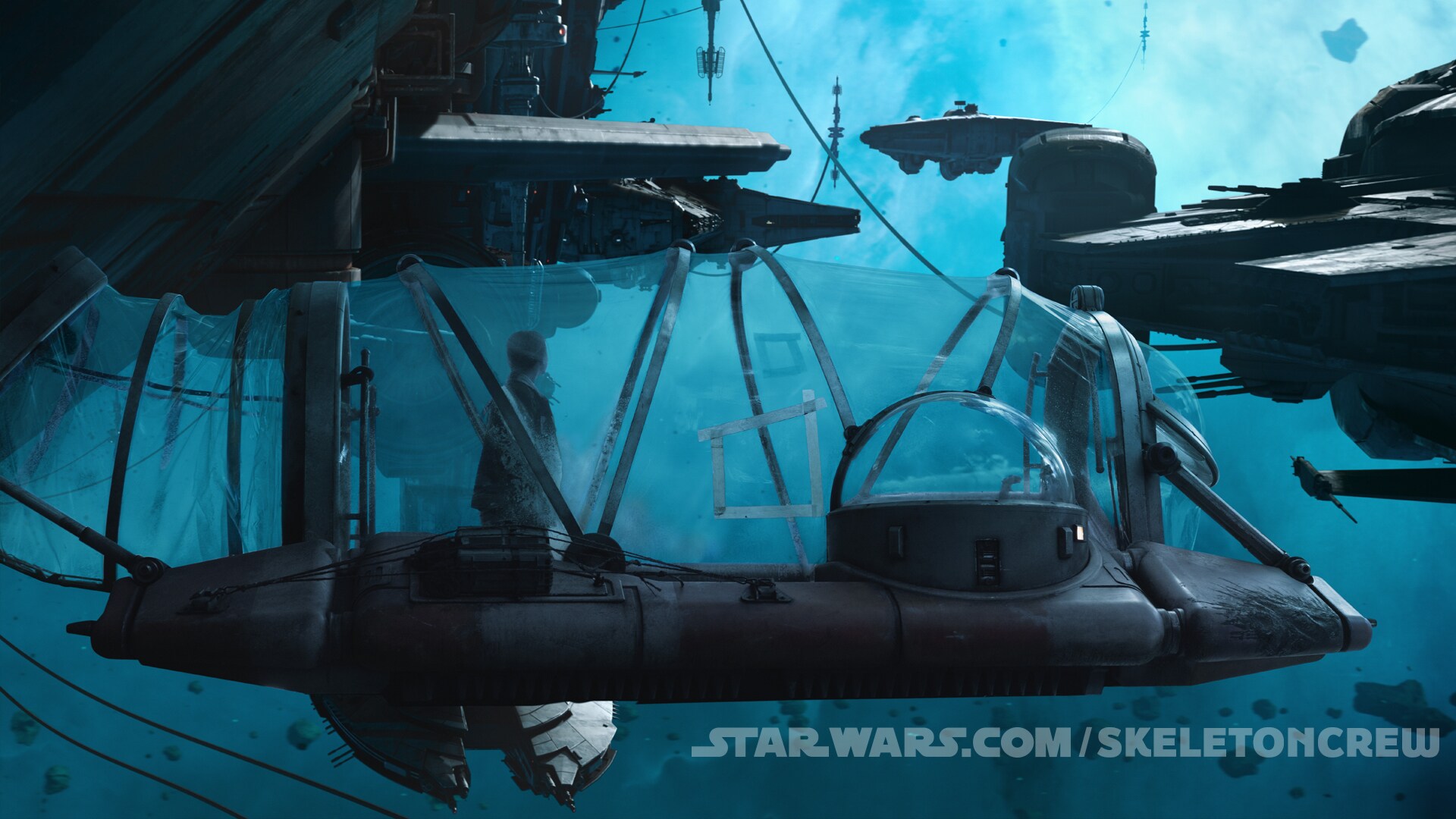
Instead of rowboats, designers created bubble-like dinghies, including one operated by a Teek. “Those floating taxis were really important because the analogy in our world is that these are rowboats going from the pirate ships to the dock,” adds Chiang. “We gave them this really interesting quality so that they look very delicate and you can see the passengers inside. It's taking something that's very classical in terms of what we're familiar with, and then just changing it to be a little bit more exotic. I love when we can do that because I think that the magic of Star Wars is to reference something that we're very familiar with, but then we turn it on its head.”
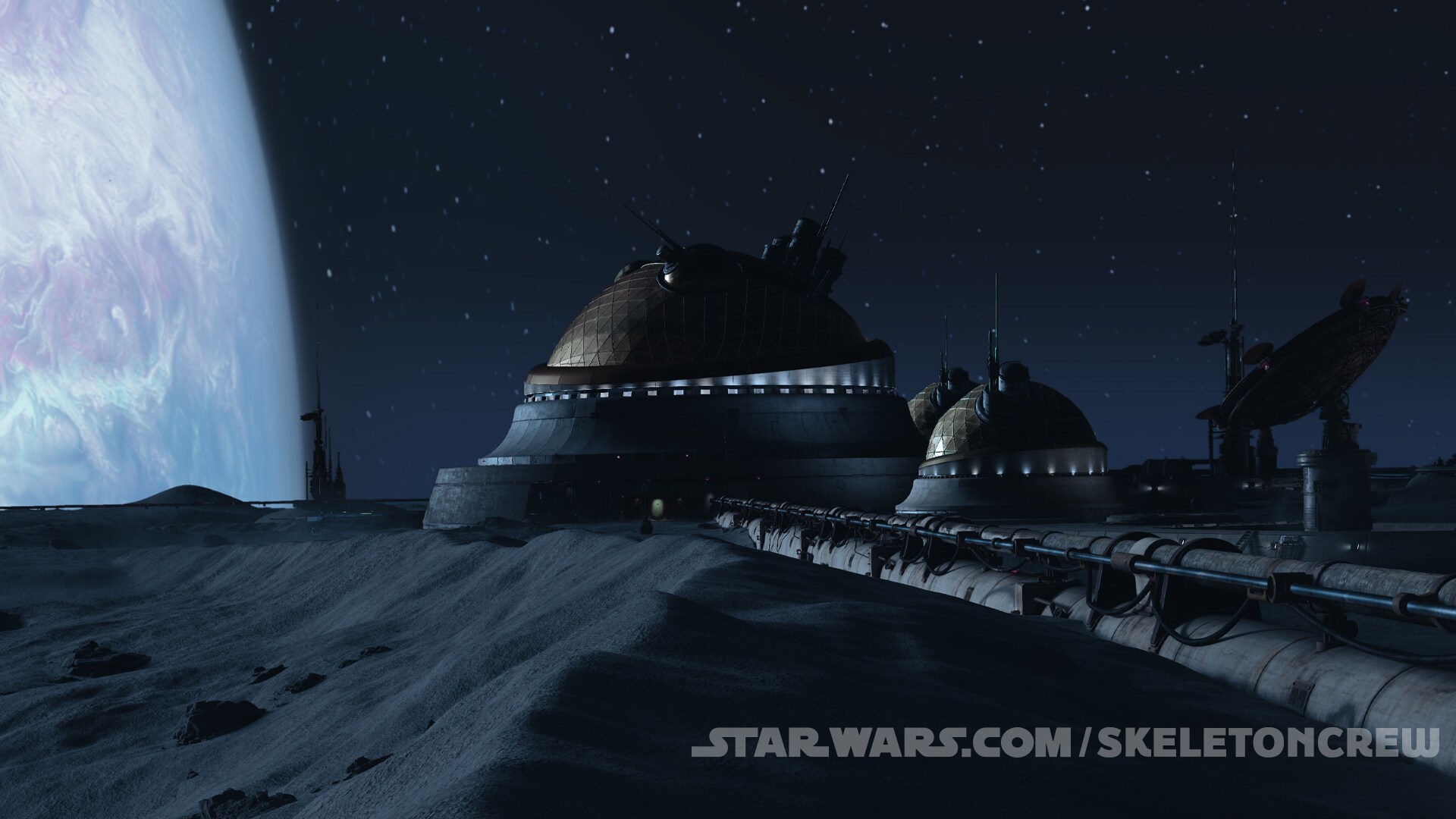
Paying a visit to the Observatory Moon
After escaping, Jod leads his new shipmates to the Observatory Moon, where he gets reacquainted with his old friend Kh’ymm. “The observatory moon was one of the really fun challenges,” Chiang says. “We wanted to deliberately lean into the idea that it was this remote outpost, an observatory/old library on this desolate moon in the shadow of this gas giant.” The idea of a barren landscape broken by the single structure works in contrast to the rest of the show’s locales. “We really wanted to make it look like a bunker, and we liked the idea of three giant doors [and three] tattletale droids…to kind of increase the level of mystery.”
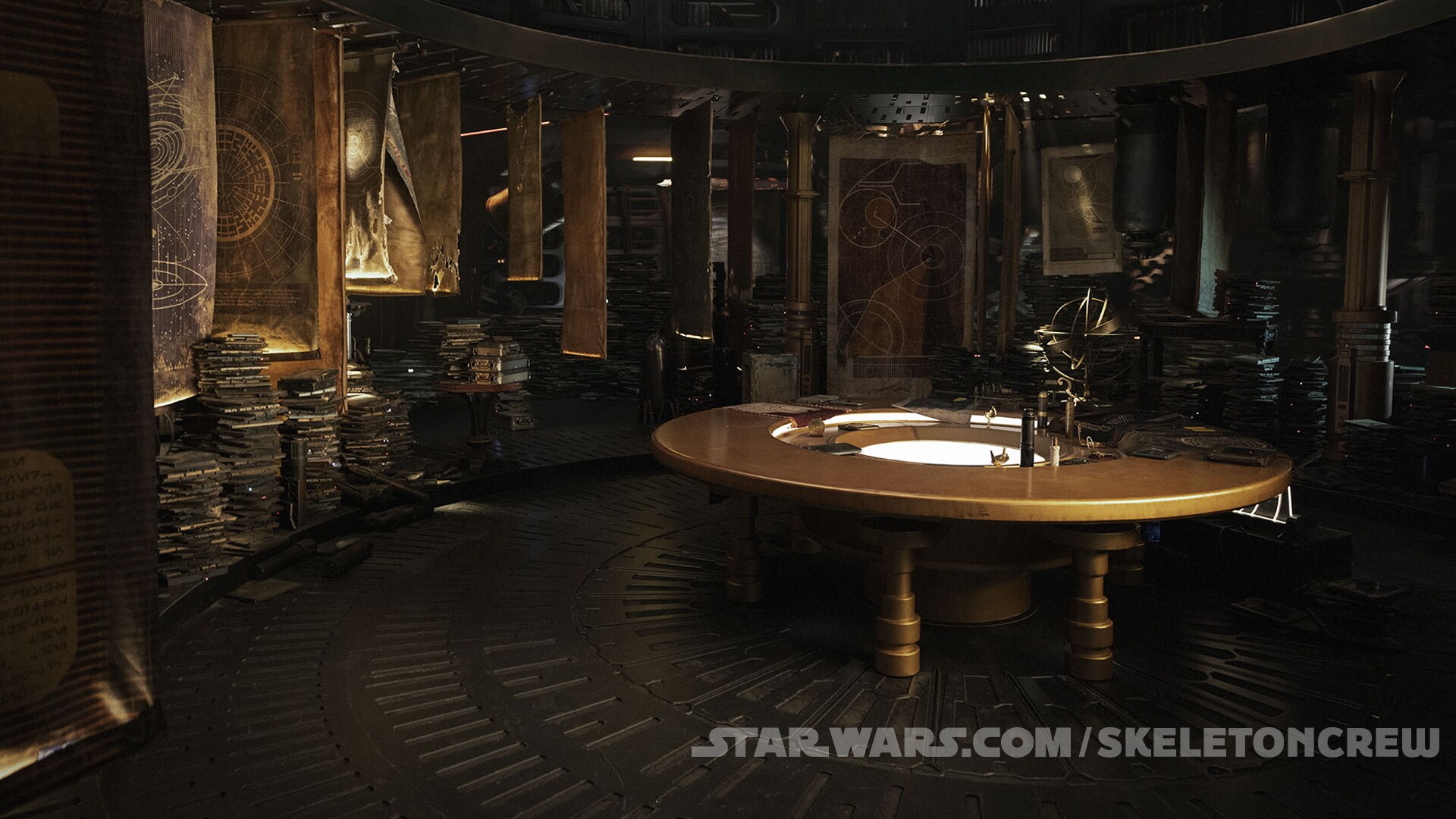
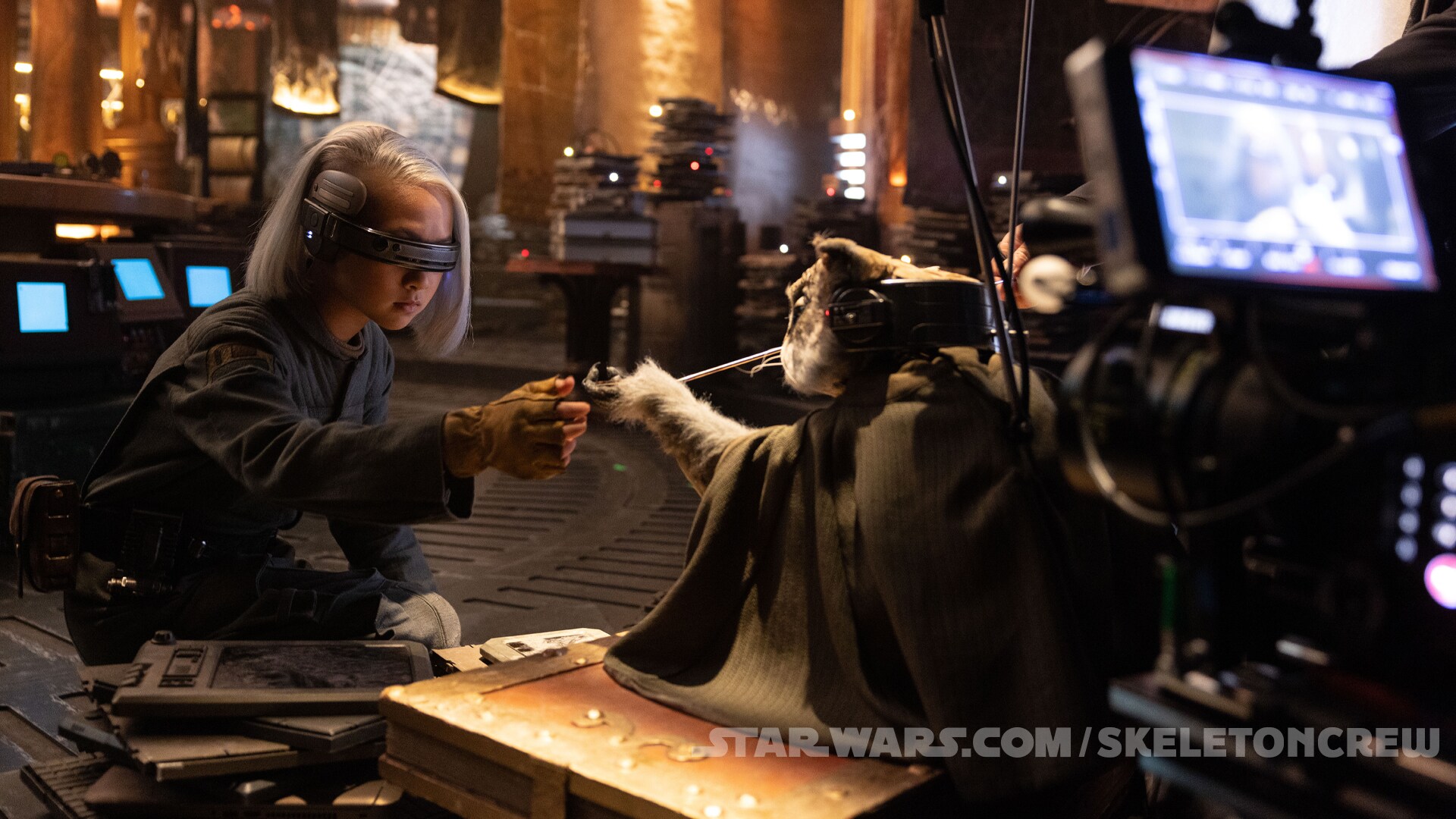
Inside, ILM’s StageCraft helped designers achieve the look of an overstuffed reference center. “This is where the Volume was really instrumental in terms of design,” Chiang says, “because Watts and Ford wanted the interior to feel like an old library, but in our world, we think of it as a room full of books.” Paper volumes are a rarity in the galaxy far, far away, so Kh’ymm’s shelves are instead stocked with datapads as far as the eye can see (and maybe even beyond that.) “What was terrific about the Volume is that it allowed us to design the room in its entirety in our most aspirational version,” Chiang says, complete with walls slowly rotating around the action at the center of the tower. “If we were to actually try to do that as a physical set, it would've been enormously expensive and complicated,” he notes. “Watts and Ford were really excited. It was their idea to get some dynamic movement in there because this is something that we've never seen.”
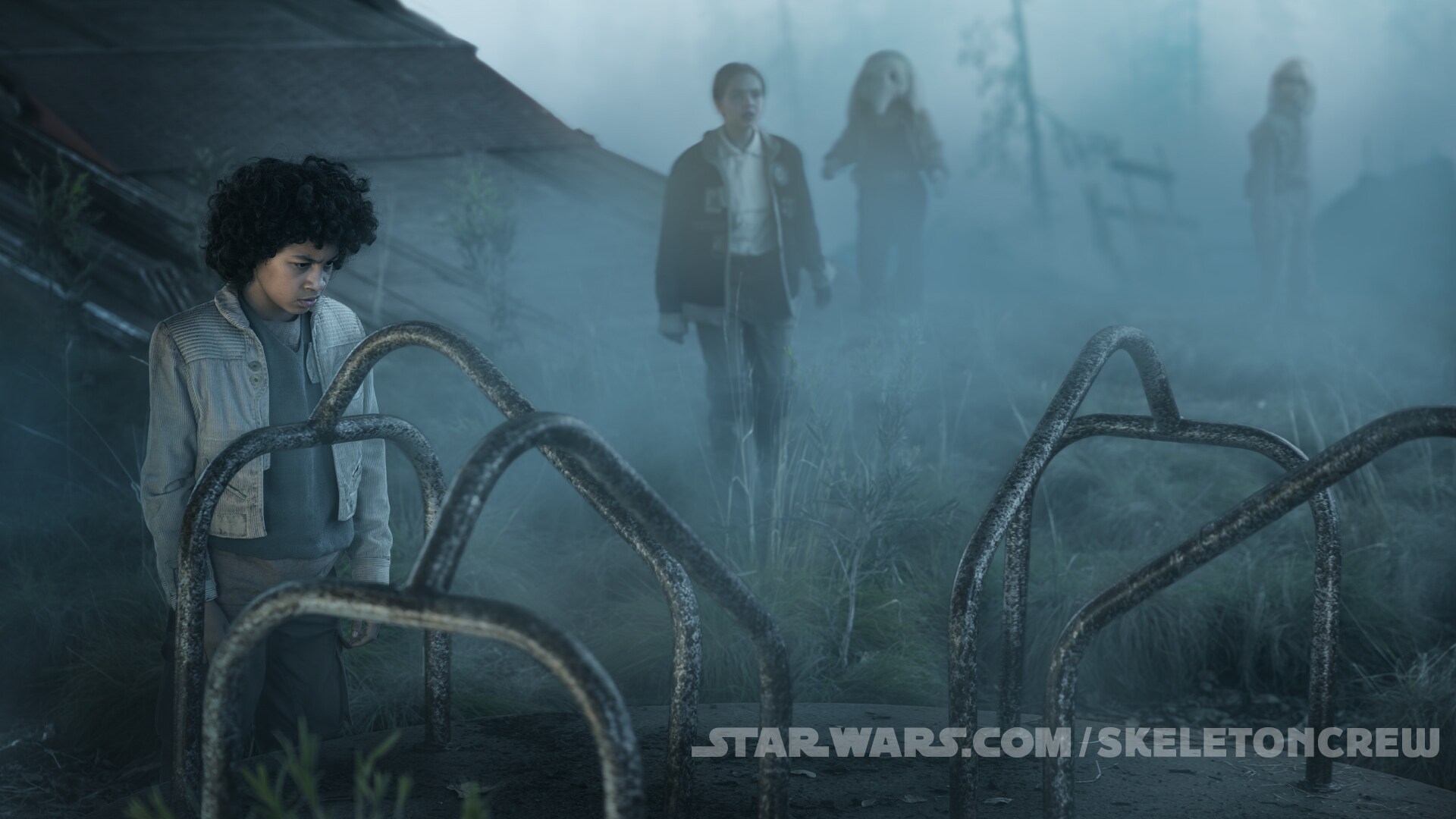
The strange new world of At Achrann
Much of the design elements for At Achrann were worked out as the core design for At Attin took shape. Afterall, from the sky, the circular cityscape had to look nearly identical to the homeworld seen in the series premiere. “The trick was that once they land, they realize they're on At Achrann and it's dystopic,” Chiang says.
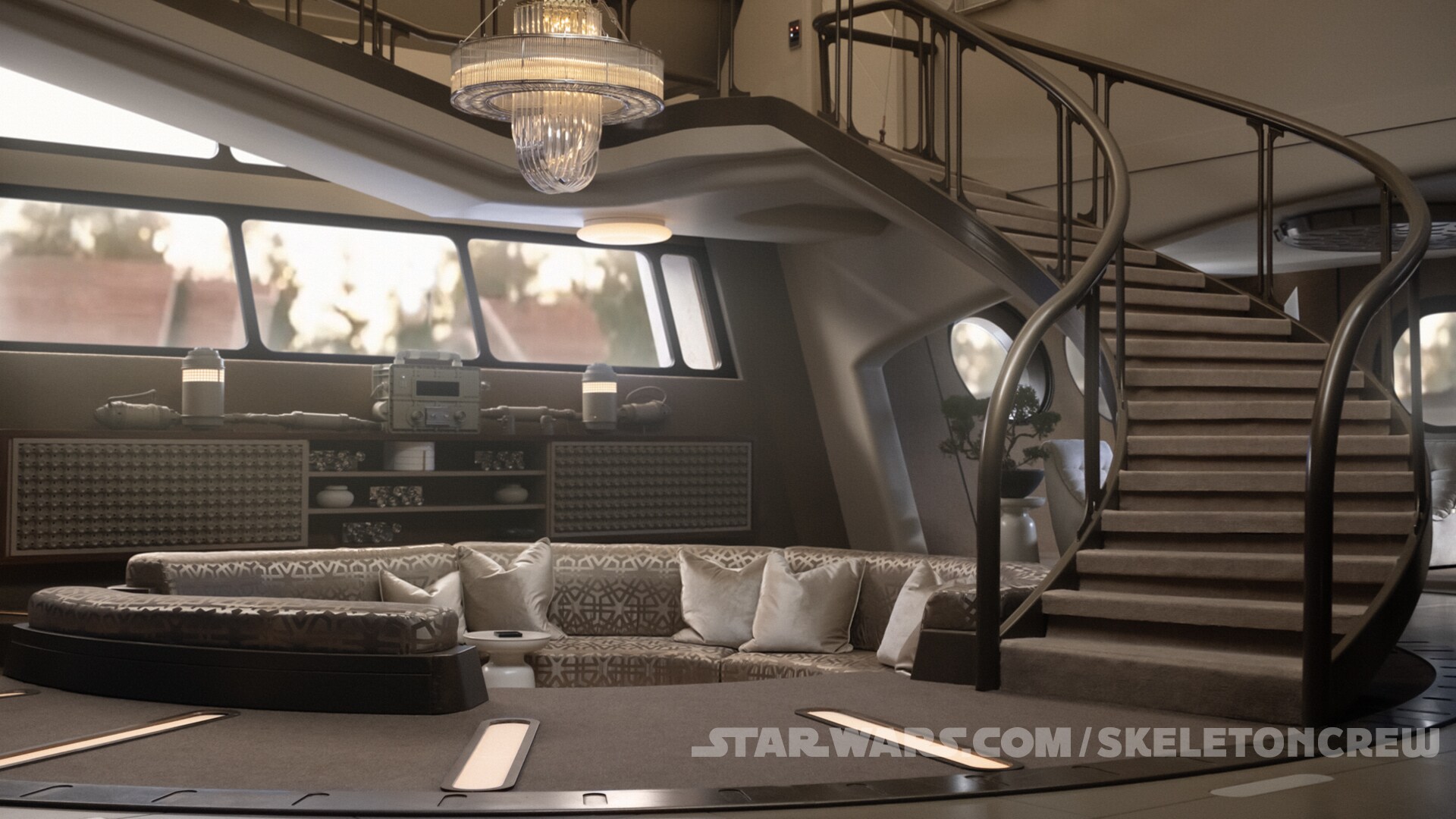
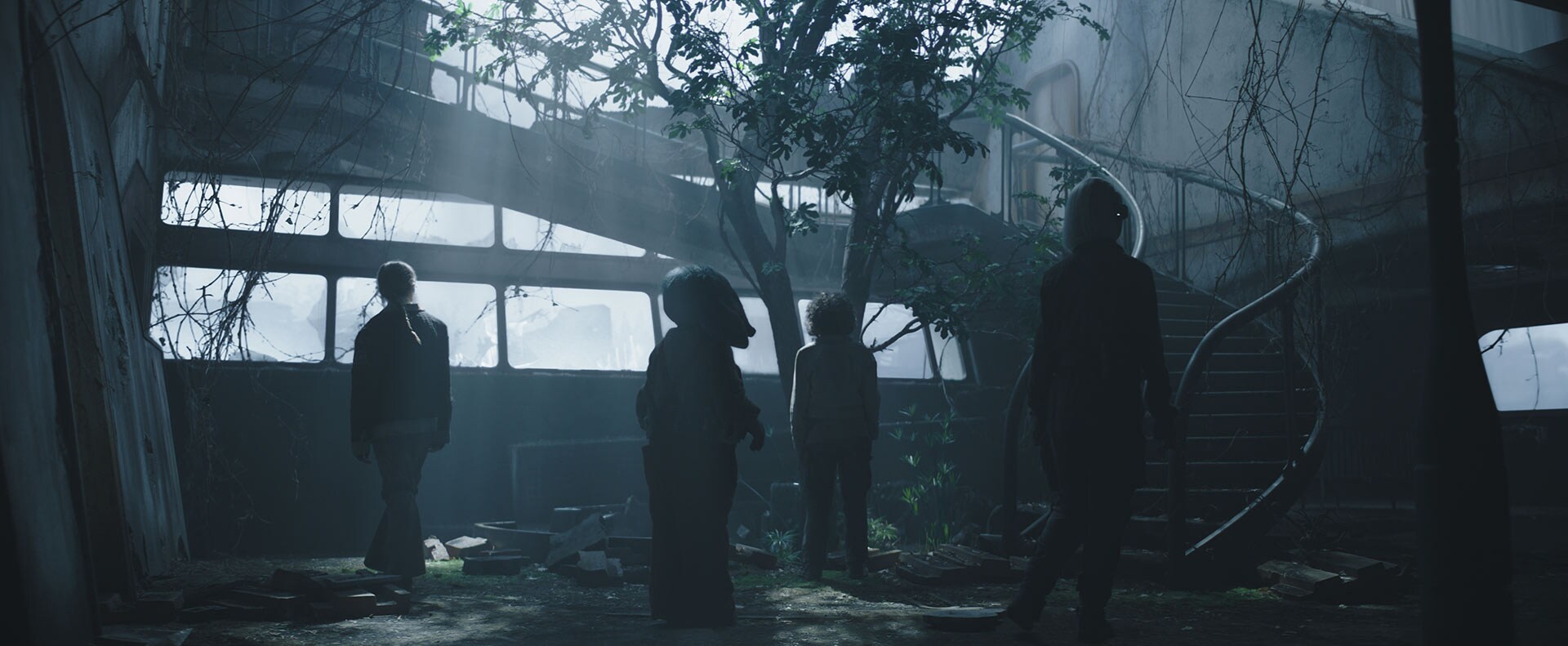
Although much of the design work involved changing the lighting and adding vegetation and other elements to the familiar silhouette of At Attin, the warring clans on the planet’s surface gave Chiang the chance to resurrect an old tank design from the prequels. “We actually used some old designs of the [Armored Assault Tanks] from the prequels,” Chiang says. “There were some preliminary designs that I had drawn that George [Lucas] had approved,” but that were ultimately not used in the films. “We snuck those in here and I like that connection because there is a little bit of mystery of At Achrann. It is locked away in time and that gave us license to layer in all these different Easter eggs.”
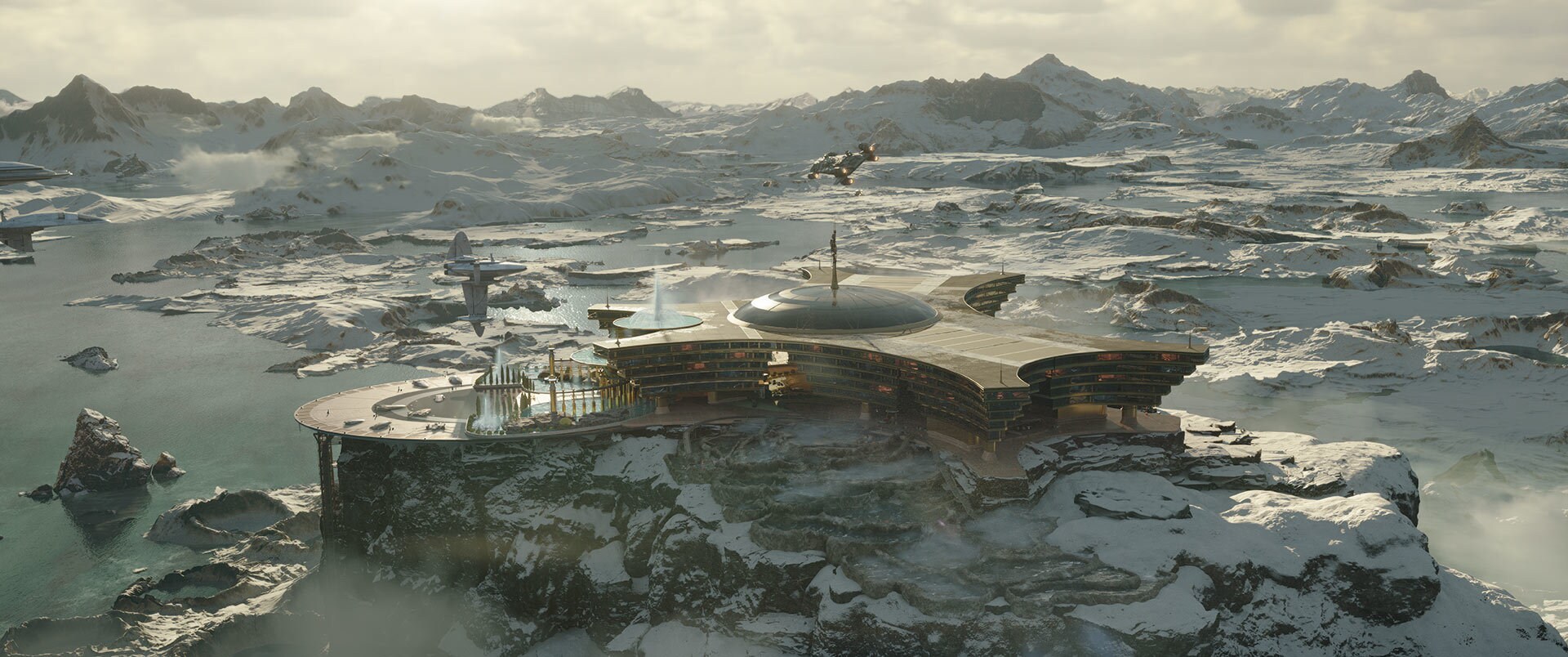
Greetings from Lanupa
The home of Pirate Captain Tak Rennod’s hidden lair, Lanupa gave designers artistic license to imagine four unique spaces on the all-new world: the relaxing luxury of a hotel spa, the dark underground mud pits, Rennod’s hidden treasure room, and the snowy dump site of the world’s detritus.
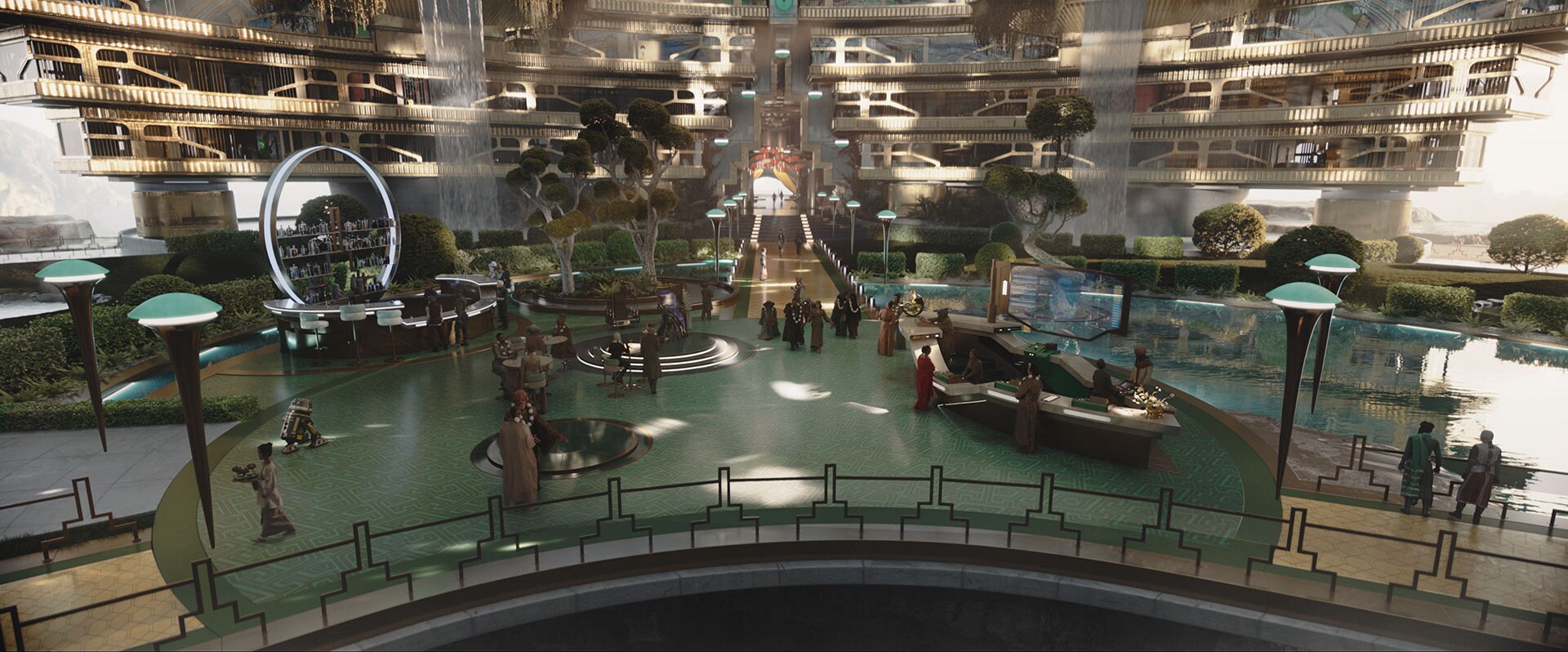
“Lanupa was really fun,” Chiang says. “The idea was to create something that was almost Las Vegas-inspired, a hotel and casino where it was very glitzy, a lot of gold, a lot of detail, a lot of architectural flourishes. That gave us the opportunity to create a different aesthetic for Star Wars, leaning into sleek, modern and elegant, because this was an upscale hotel.” Hints of Naboo architecture from the prequel trilogy and the Canto Bight casino from Star Wars: The Last Jedi can also be found in the design, which evokes the grandeur of an upscale playground.
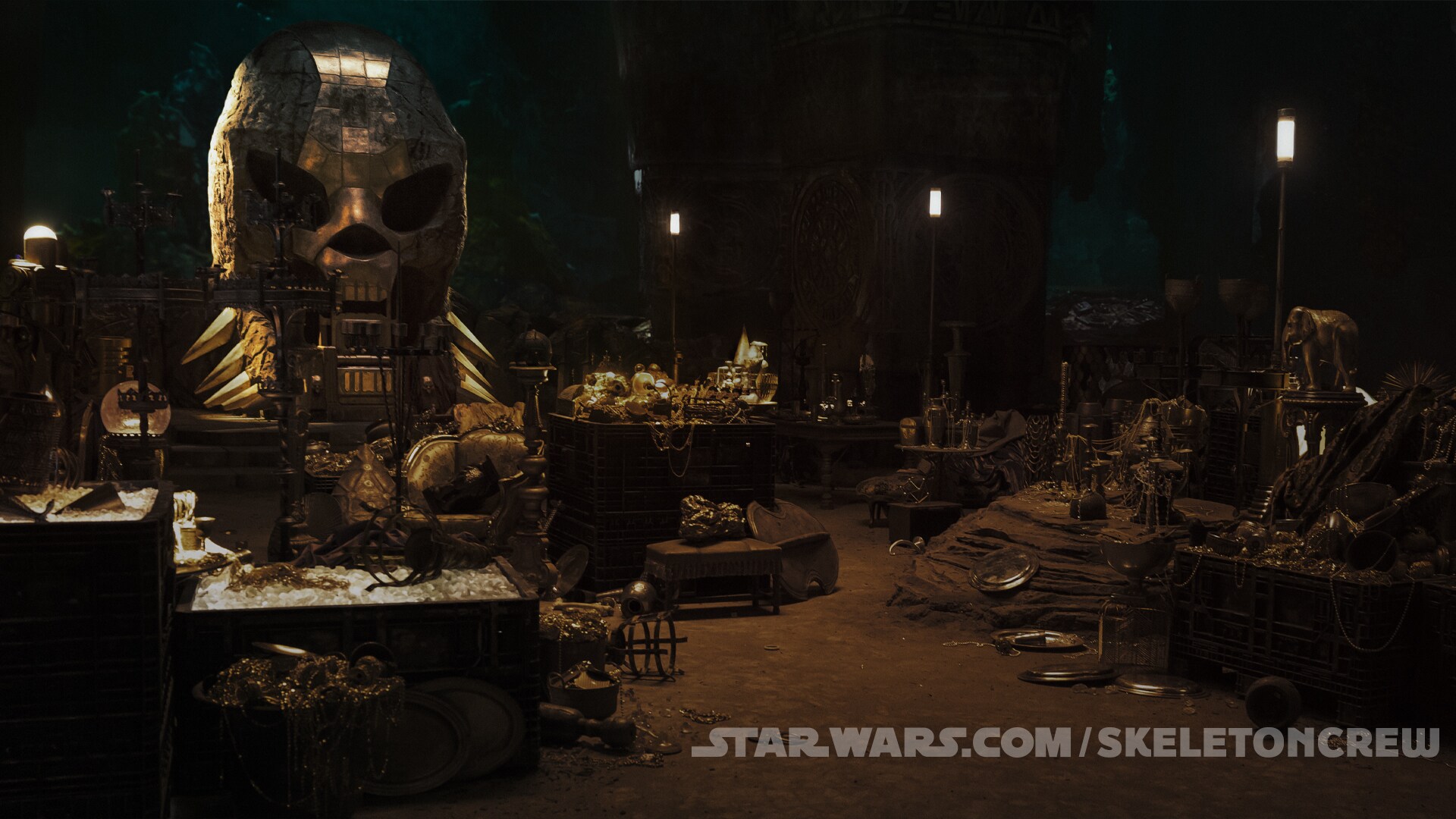
The glamorous resort is built on top of naturally occurring mineral pools and concealed deep underground is an old pirate alcove. “In the catacombs, you discover this treasure trove room,” Chiang says, the fusion of a booby-trapped tomb from Indiana Jones and the greatest treasures from the Pirates of the Caribbean franchise. The treasure room is filled with Easter eggs, including podracer engines and recognizable droids, Chiang says, all surrounding what appears to be a massive Weequay skull. “The centerpiece is this giant abstract skull. The idea that the pirates would have a throne that was in the shape of a skull was really important so we went overboard.”
On the flip side, the trash crabs skittering across the garbage-covered underbelly of the world gave designers the chance to collaborate with Tippett Studio and ILM to create the giant Mama Crab and her minions, respectively.
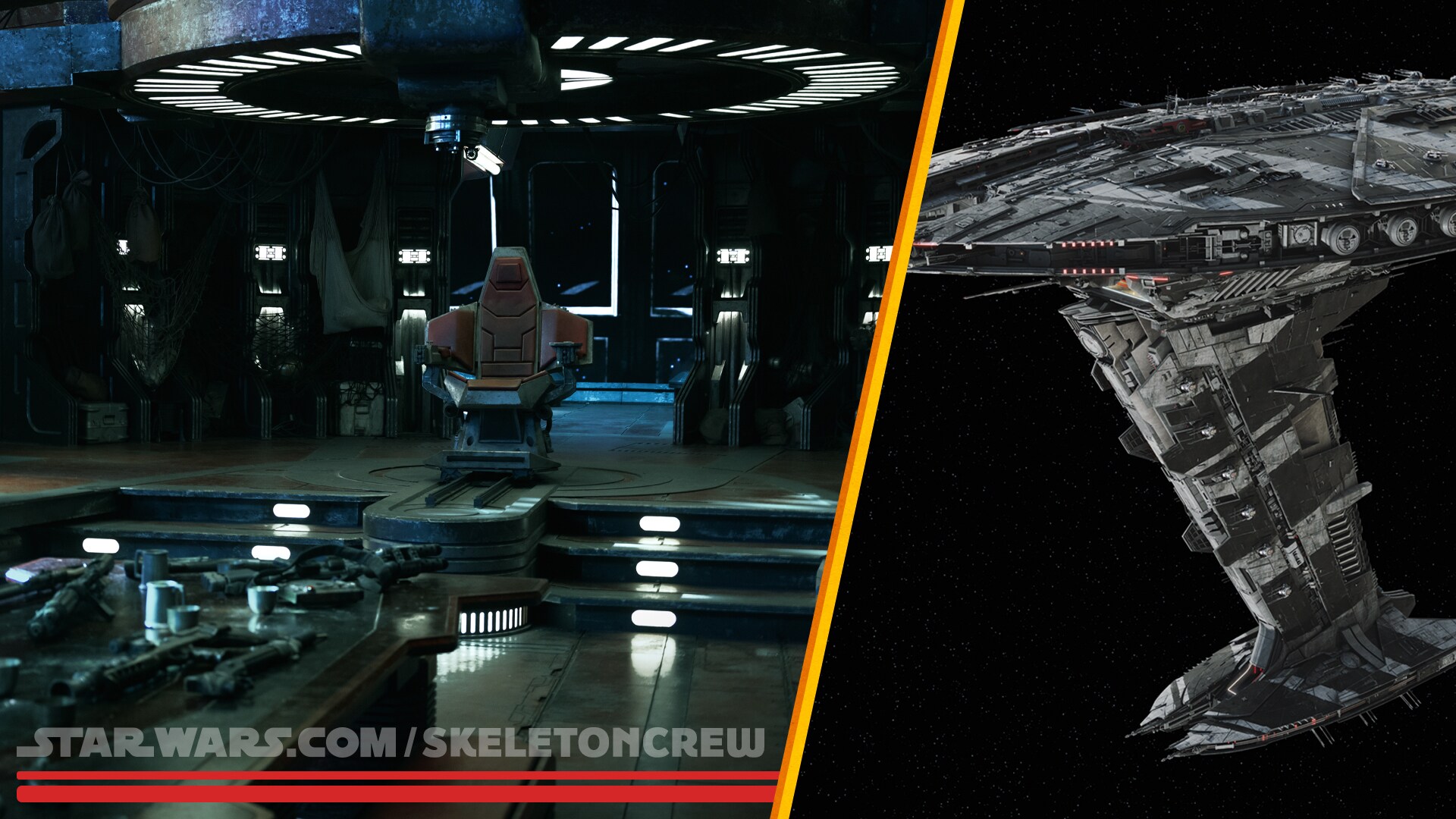
The pirate frigate
For the bridge of Brutus’ pirate frigate, the crew once again leaned into the limitless potential of the StageCraft volume. “I wanted to take the bridge and open it up,” Chiang says, essentially putting windows on all sides for a clear view of the stars just outside. “That allowed us almost a 180-degree view of space, and that was something that we haven't really done before for a Star Wars bridge.”
But one element that never made it past the concepting phase was a pirate’s banquet. “One idea that we had early on was that the floor in the center actually rose up to have this big banquet table,” Chiang recalls. “It was a fun idea because, of course, on a pirate ship you have to have a big banquet and we thought that would be a fun way to take advantage of this giant bridge.” Instead, the bridge became the location of Jod’s tribunal, a different kind of dual purpose.
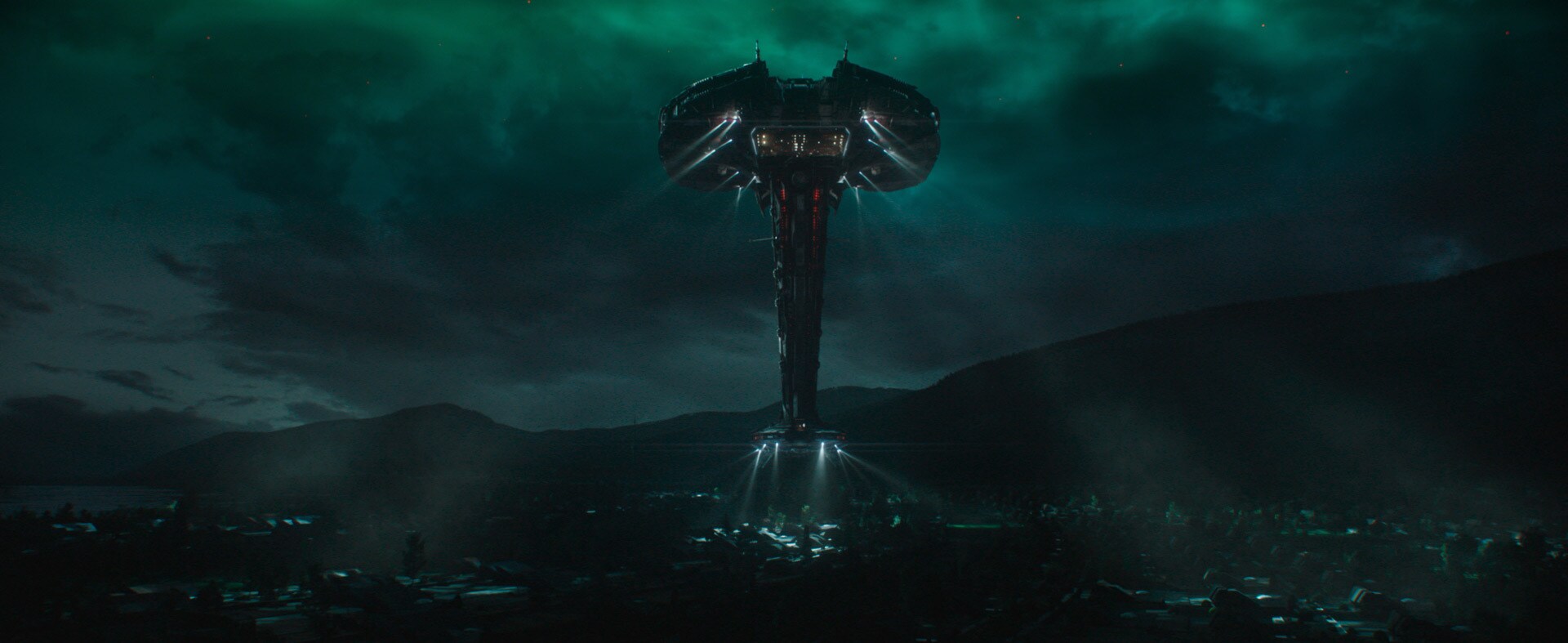
When the pirates arrive on At Attin, the frigate makes an unforgettable entrance through the clouds as the hulking ship makes planetfall. Designers were inspired by the mothership in Close Encounters of the Third Kind and other classic flying saucer shapes as well as the keel on the underside of Earth-bound seafaring ships. “We wanted to keep the top very much like a saucer, very old school, but then we gave it this very long keel,” says Chiang. “We knew that in the finale it was going to come through the atmosphere, and I wanted to come up with something that was visually very compelling, almost like an alien spaceship coming down. It's a really powerful image because it looks like a gigantic anvil coming down into the suburbs.”
Watch all episodes of Star Wars: Skeleton Crew only on Disney+.

